Building a Belcher
Islands kayak frame
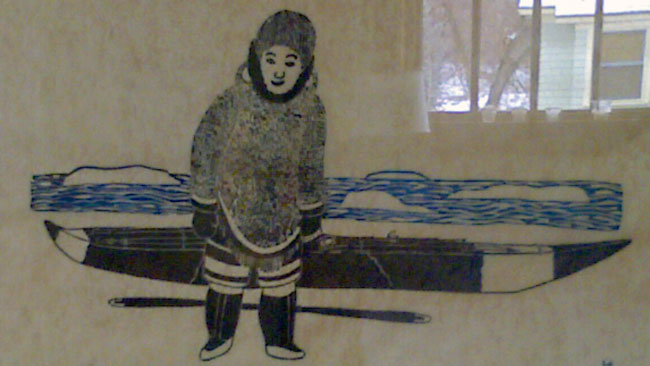
Me: "Belcher where?"
Harvey: "They're on the east side of Hudson Bay."
Me: "Your talking to a guy who didn't know where Kansas was until last week."
This spring I received a very unique commission. A gentleman contacted me with a photo of a soapstone print depicting an Eskimo and his kayak. The print had been given to him by his father and he wanted to know what sort of kayak might be represented and whether or not I would be interested in reproducing an nearly exact copy of the original framework (at 3/4 scale) for display. The terms of the commission were that I would research the kayak and produce the frame using no power tools; terms to which I added that I would attempt to recreate the kayak with the tools available to the original builders.
Personally, I hadn't the faintest clue where the kayak might be from, but I did know someone who would. I'm fortunate to have the worlds' eminant kayak researcher for a best friend and a trip to Harvey Goldens house did not dissapoint. In his museum-like living room Harvey pulled books from high shelves, unrolled surveys, and in short order assembled me a binder of relevant information including detailed studies by Eugene Arima, Milton Freeman, and David Zimmerly. The historic photos, surveys, and drawings in these studies provided a strong foundation to begin the process.

Milton Freemans study contained an actual tool list that I used as a guideline for my own tool kit. Originally, little more than an adze, bow drill, and curved knife were used to craft the kayaks. With more European contact came the steel hammer, hewing axe, and brace and bit. More importantly (in my opinion) than exactly what tools were used was how they were obtained. The inuit in general were very financially limited and available tools must have been built, borrowed, converted from other uses, or cooperatively owned. One might imagine the occasional new tool being purchased. I tried to keep this spirit in my own tool kit, the following is a list of my tools and their sources.
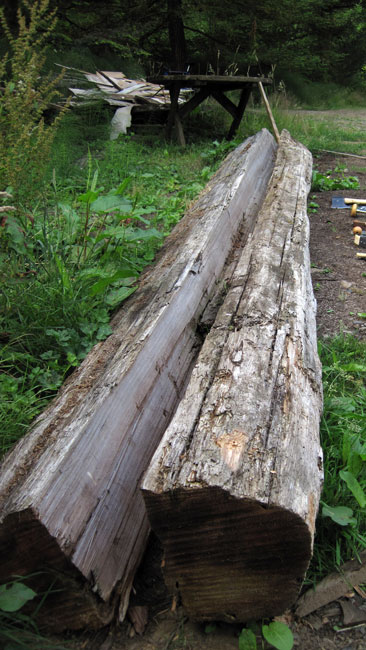
Two years ago my friend Mark and I were out in our kayaks salvaging logs on the river after a flood created several sizable logjams. Wielding chainsaws, cables, and comealongs we liberated a reasonable raft of timber, at no small risk to ourselves! as we were ready to leave for the day, I spotted this rotten looking chunk floating in the mass of debris and pushed it over to the raft. My instincts were right, inside the rough exterior of the broken chunk was a good quantity of very straight, clear grained red cedar. I split the log once to check the interior and then set it aside for a day when I might use it to make a kayak with only hand tools.
Building the kayak: Day 1
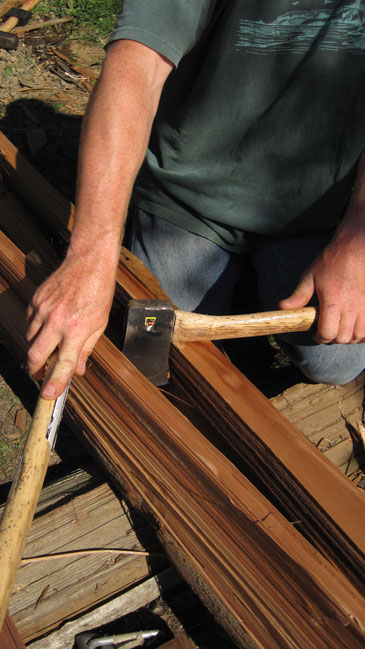
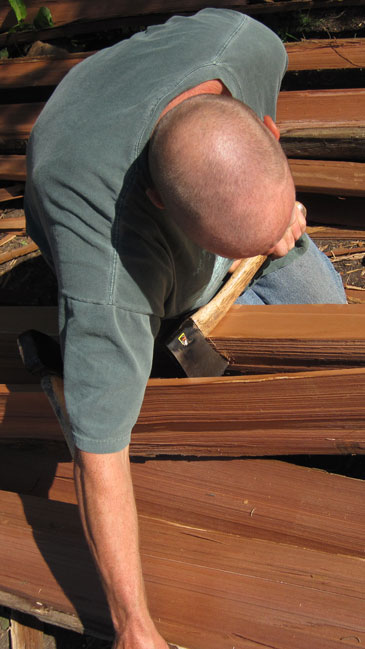
I took a deep breath and started splitting with a hammer, axes, and wedges. I tried several techniques to get the best split planks. On thinner stock one can control a split by hammering in wedges along a line that mostly follows the grain and then split the plank, but that techniques only created shards with such tall boards. Ultimately I found the bisecting pieces again and again yielded the best planks.
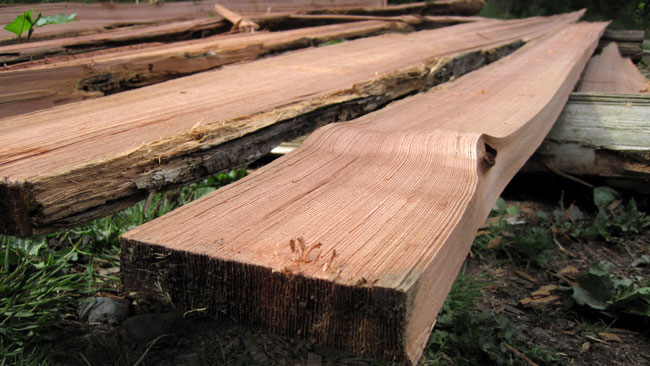
Of course even the best planks varied in thickness by up to an inch at either end. After splitting out the entire log, I ended up with three usable gunwale boards, and about four boards from which to fashion chines and stringers. Aside from that was a pile of bad boards from which I still might use pieces here and there.
At the end of the first day I looked upon my pile of split planks with a mixture of elation and anxiety as I contemplated what would be needed to hew them accurately into the thickness and complex curves neccesary to form the gunwales. I returned to Harvey's binder and noticed all of the studies and most of the photos showed two or more men working to complete a kayak. I also noticed the prominence of a proper hewing adze. That evening I emailed my friend Tom...
Day 2
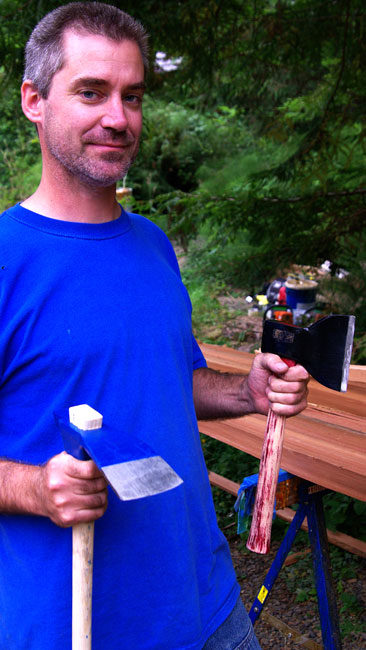
I'd like to say that Tom came to work in exchage for half of a freshly killed elk or something of that sort, but truth be told I hired him outright. There is more to the story though. Last year I met Tom when I traded him a kayak building class for help in completing the house that I built with the logs I pulled from the river with Mark. I realized pretty quickly that Tom is an excellent carpenter and ended up hiring him for a few more weeks. I hired him with money I borrowed though, and the profits from the commission we'll be building together will go partially to finally pay that debt. This is one of those rare moments where currency is truly a friendly intermediary in trade. Cash is undoubtedly the most convenient way to transfer value, but with that convenience it also erases the rich relationships that direct trade fosters. With that in mind I felt a little bit sheepish shelling over a substantial amount of cash for this brand new broad axe and hewing adze. My firewood hatchet simply wasn't going to get the job done.
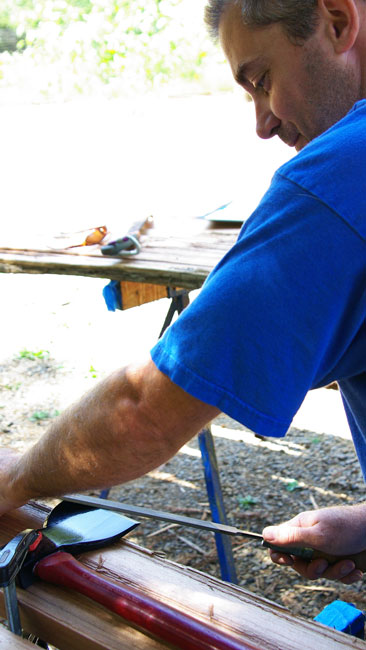
The first thing I did was hand Tom the binder. "Here you go," I said, "first you're getting paid to read." Afterwards reading the binder cover to cover, Tom set to work with a mill file and diamond file, sharpening the edges of all of our tools. I've made the mistake of handing that job to the wrong people before only to have them ruin all my blades, Tom is more than capable though.
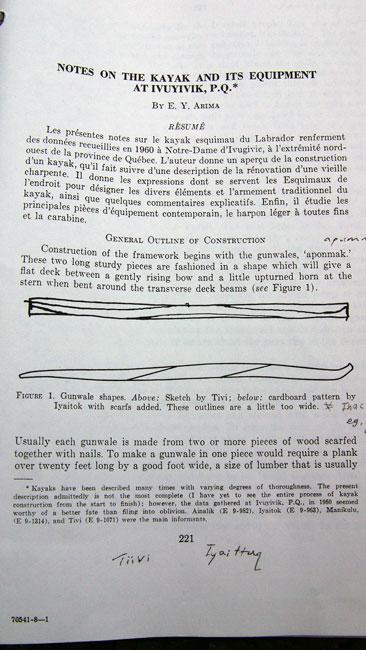
One of the most difficult tasks was creating an accurate gunwale template. The above illustration shows roughly how the gunwales should be shaped to create the correct sheer line. We needed something more definate though, before we took and adze to our precious split planks. I read and reread the parts on shaping, looked at all the surveys, and stared at the grainy photos until my eyes went blurry.
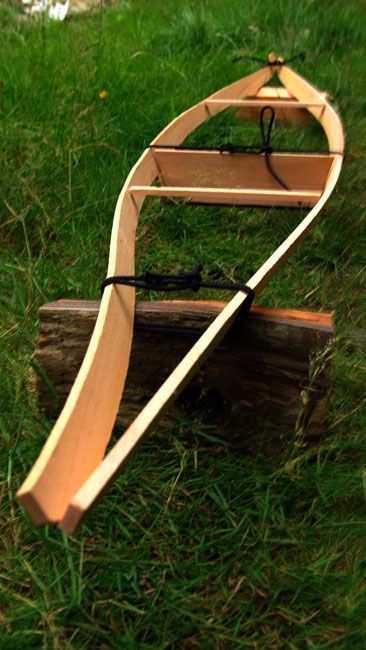
After about 3 hours of trial and error Tom and I created this half-scale model of the full size gunwales to use as a shaping guide for the full size gunwales. The template shape ultimately ended up agreeing very closely with the illustration above. From the exercise we gained both a vertical height for the plank we needed, and the confidence to move forward on the actual planks.
Day 3
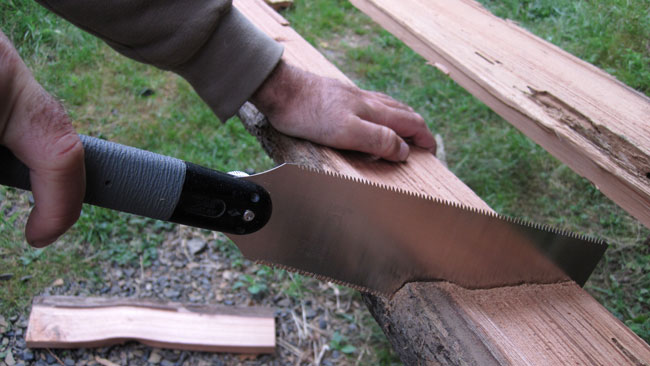
After a short review of the drawings and our model frame, our first task was to cut the gunwales to length, 12 feet 7 inches to make 3/4 scale. At 14 -18 feet the Belcher kayaks were quite short for their region. Even this decision took some time as we carefully examined the boards and chose the cuts to allow cracks, rot, and other defects to fall outside the finished gunwale lines.
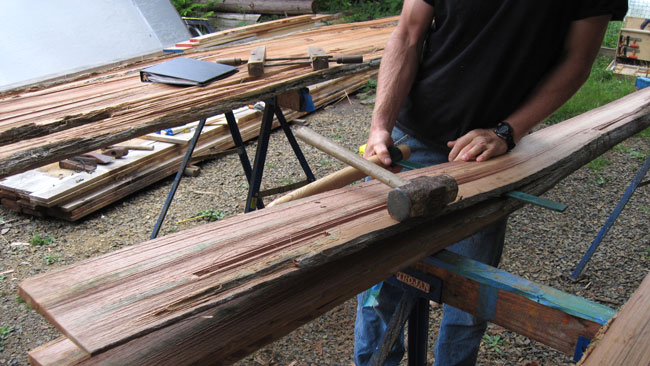
The planks were still quite thick so I carefully drove a froe into the ends to thin them down.
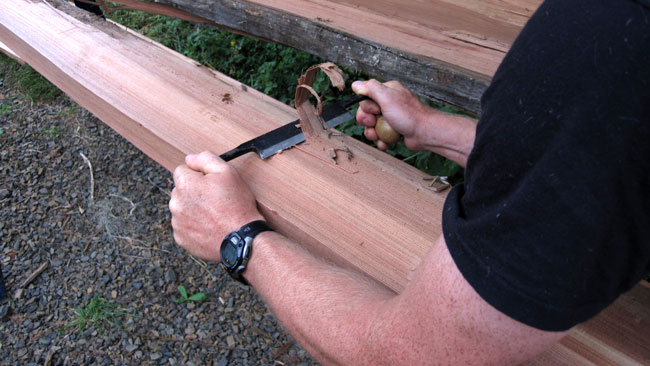
I then used the small drawknife to clean up the surfaces and make the plank reasonably flat and straight, alternately cutting and flipping the plank on edge to sight the line.
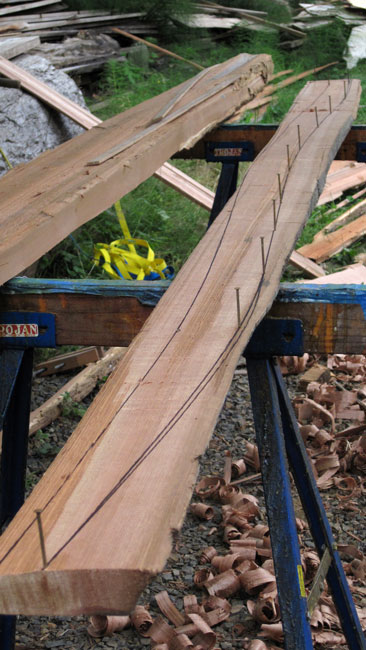
With a clean surface I layed out the gunwales according to the measurements we determined yesterday.
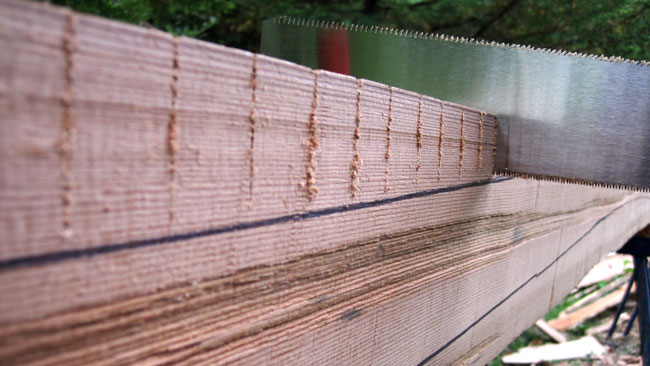
Originally this shape would have been adzed but neither of us are good enough with the adze yet to take such bold bites, so we chose to cut down to the lines.
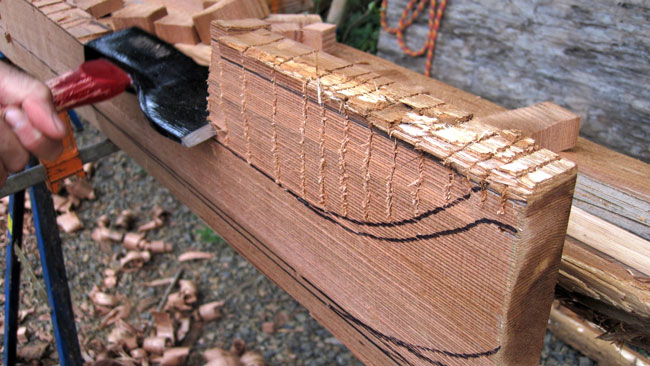
We used the broad axe to chop out the kerfs.

The stern 'knob' on this kayak is quite pronouced.
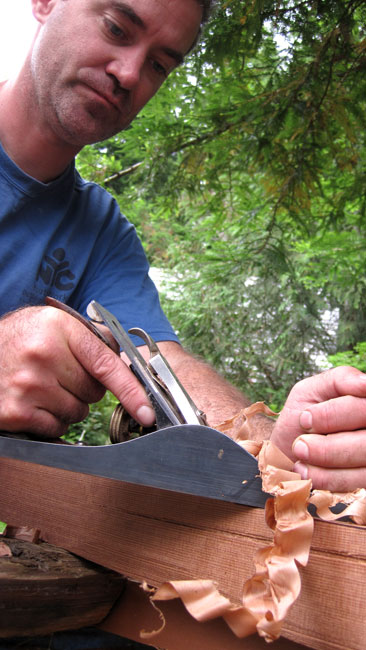
Tom tried planing the rough edge...
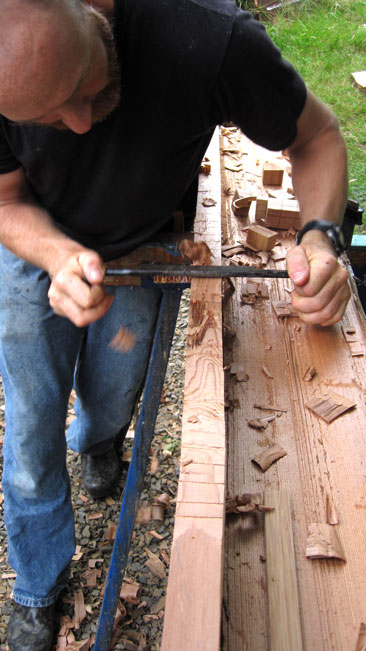
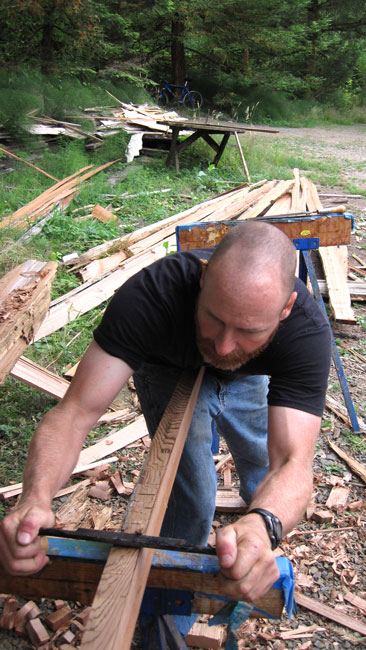
...but we both decided the draw knife worked better.
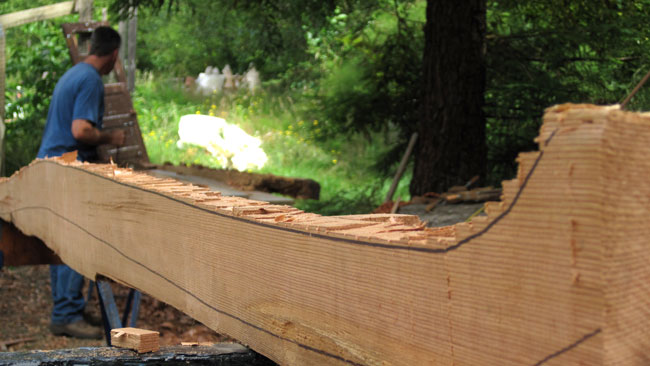
The finished shape is laid onto the second plank and traced for a matching gunwale.
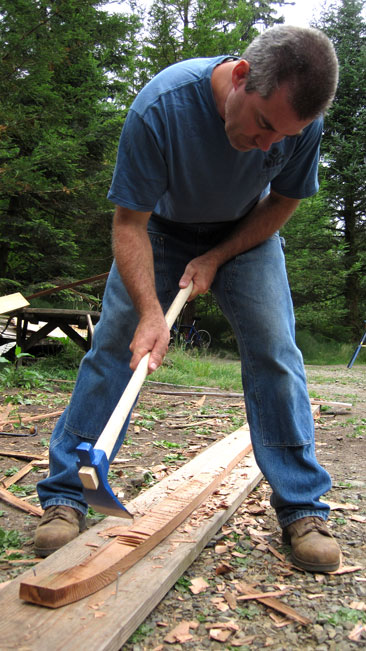
The gunwales are still nearly twice as thick as they should be. Tom removes thickness with the adze but again we are both nervous with the agressive hewing adze, it would be easy to ruin the gunwales with a single stroke.
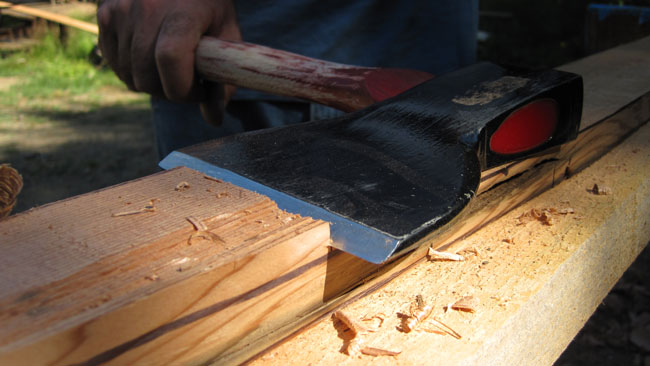
We discovered that by referencing a flat surface we could accurately scribe that surface onto the gunwale. Then we cut kerfs down to the line every eight inches and chopped out the wood with the broad axe.
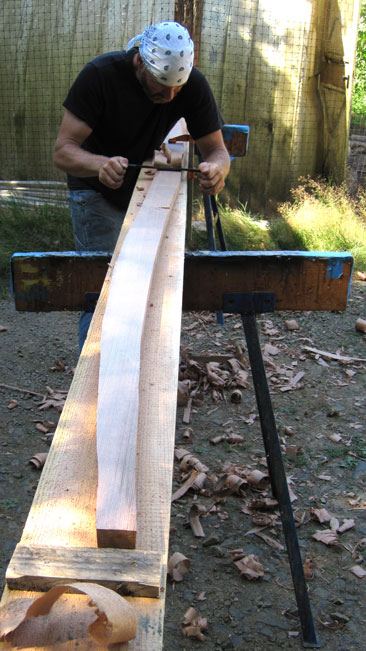
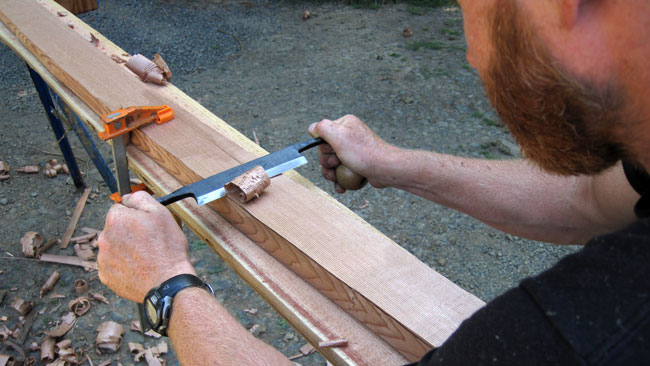
We finished the surfaces to their final thickness (aprox. 3/4 inch) with the draw knife.
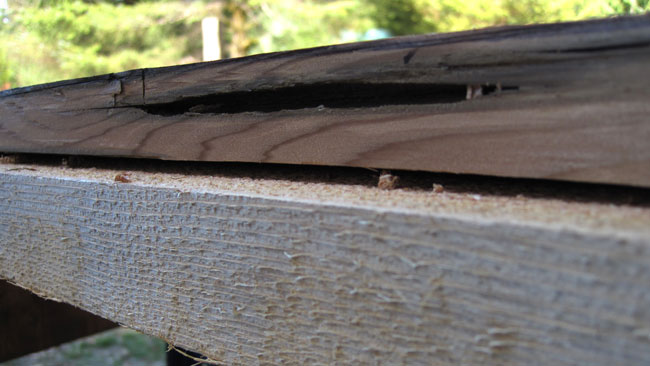
Not all defects can be avoided. This deep void in the bottom of one gunwale only became apparant near the end of the shaping. It shouldn't be a problem.
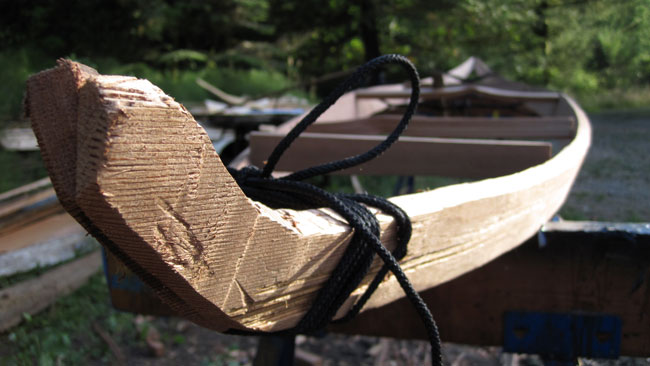
With the gunwales complete we tied the ends together and forced in spreaders that were little more that quickly split sticks. With one guy holding and the other pulling a saw through the tips we were able to fix a reasonably appropriate flare. I accidentally cut myself and the rope during this procedure. The stern was VERY difficult to force closed as the bend it takes forces the gunwales close to breaking.
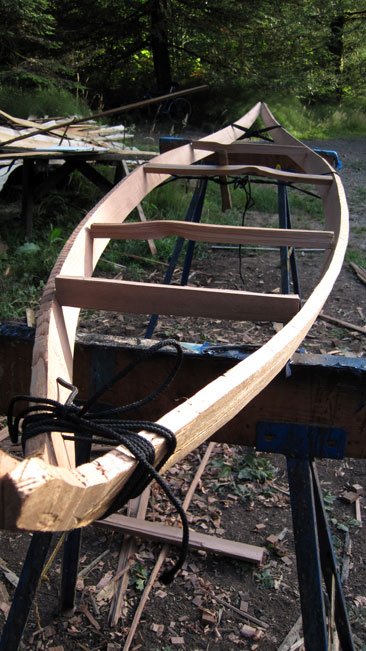
Our progress for the day. Both Tom and I noticed that our finished sheer was slightly humped up in the middle. This absolutely perplexed both of us because they are exact copies of the smaller model we made, with a flat sheer in the middle. We increased the flare slightly which helped and still kept the flare within historic parameters. Nevertheless, in the morning we will need to reshape the gunwales a bit to get an accurate sheer line.
Day 4
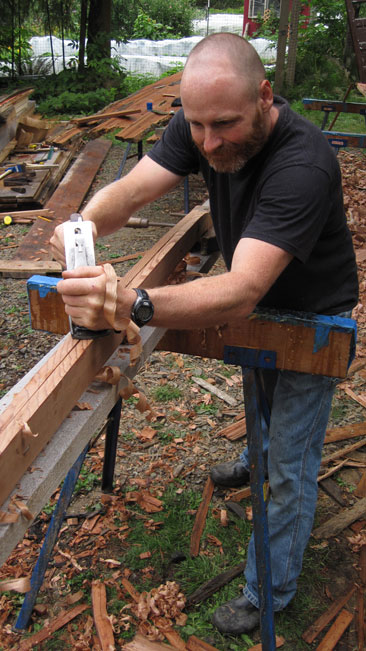
I spent the early morning reshaping the gunwales. I took this opportunity to also thin the ends somewhat to make the bending easier in the stern. In the original it would have be done by sawing deep oblique cuts from the interior face, but without an elder to show me exactly how to do that it seemed like a great way to break the gunwales.
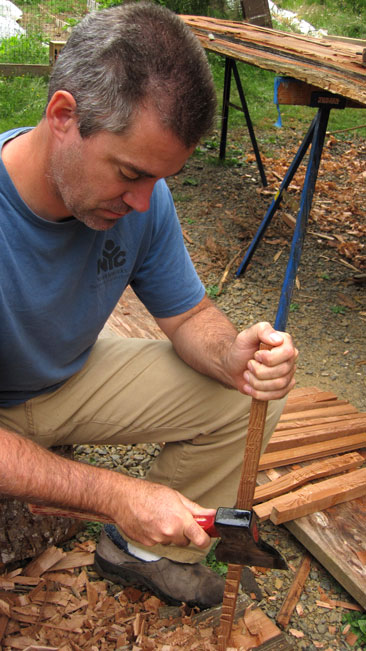
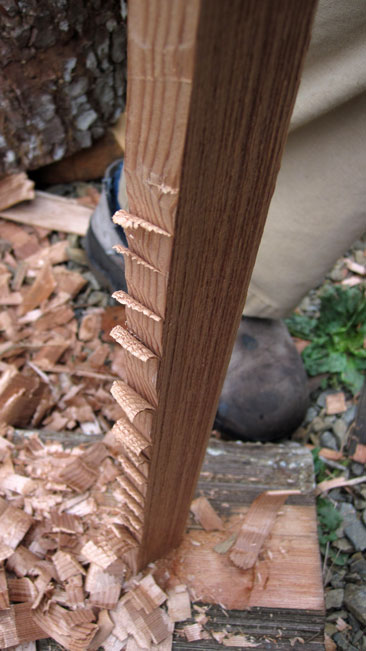
Tom worked on splitting and shaping the deck beams.
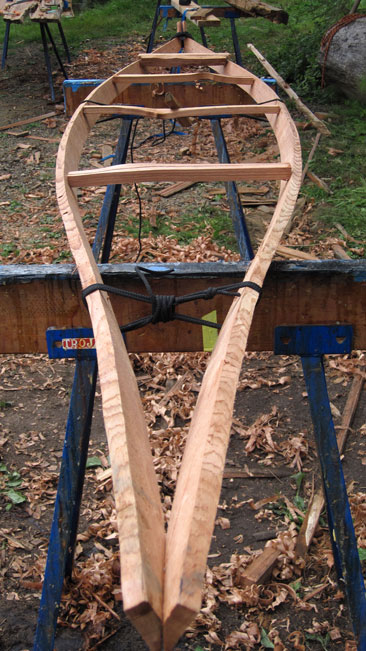
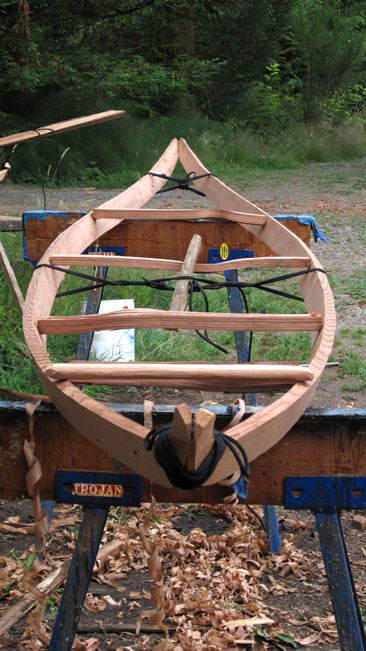
The revised sheer looked much better so we moved our attention to other tasks. I proposed we take a field trip to the beach to begin searching for a natural crook for the masik, as well as stock for the ribs.
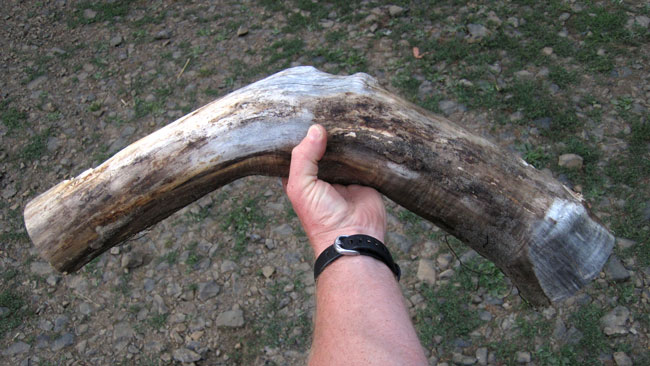
Despite an impressive driftwood supply on our local beaches, and perhaps even because of it Tom and I were having a hard time finding just the right pieces for the masik. Most of the wood was extremely dry from the summer heat and we weren't feeling really confident about finding good stock to split staves to shape into rib stock for bending. After three hours of searching on two different beaches we returned home with this single crook. More than anything, our beach forays just didn't 'feel' right.
I thought perhaps that in our desire to use beach salvaged wood for literal authenticity, we were ignoring the conceptual authenticity of the project. With the day dwindling away I decided to take a look at the situation with fresh eyes. The Inuit builders didn't find their stock in an afternoon, appropriate pieces were cooperatively gathered throughout the year from local areas.
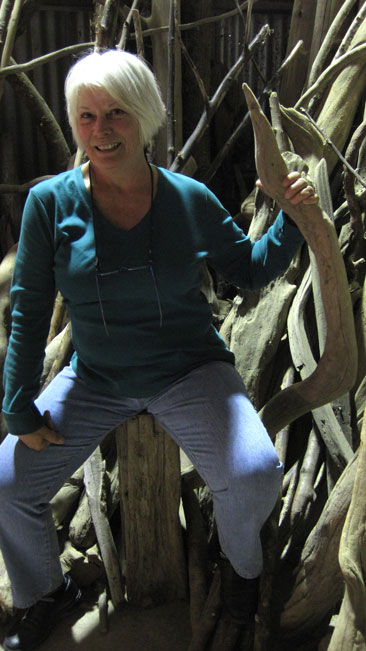
A natural furniture builder, Kathleen is the most tenacious driftwood gatherer I know. She was happy to let Tom and I pick through her crooks to look for masik stock, and the best part is that we only had to walk across the street to the shop I share with her. I will undoubtedly trade her something, likely fish or labor, for the use of her wood. After meeting with Kathleen I felt we were on the right track.
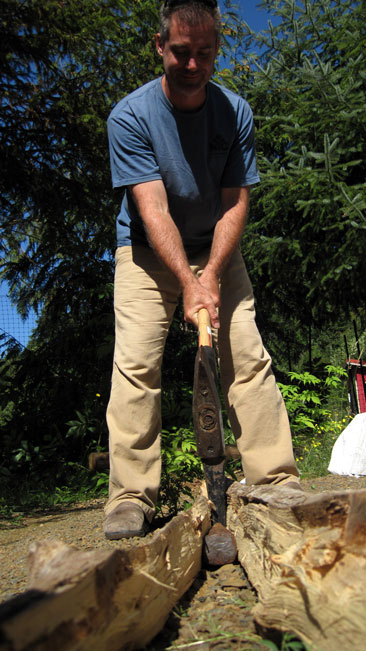
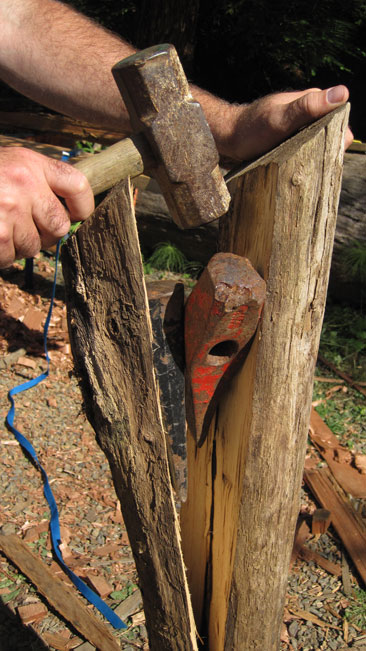
Back at my farm I looked again through my wood and found this small rough piece of black locust. Locust is incredibly strong, rot resistant, and bends very well under ideal conditions. This locust however had been drying and cracking in the sun for years and was very hard to cut and split. Locust is extremely cohesive and even in short lengths it resisted our efforts to split it.
I reflected back to where this locust actually came from, it was three years ago in the same salvage operation that our gunwale log came from that Mark peered into the murky water and said, "I think that's black locust." Naturally I assumed he was full of shit. How can anyone look at a dirty, slimy, barely visible, nondescript limb and know anything? Sure enough, it was locust and we cut it back to where our chainsaws could no longer reach down into the water.
Back in the present I looked over to Tom and mused, "I wonder if the rest of that limb is still down there?".
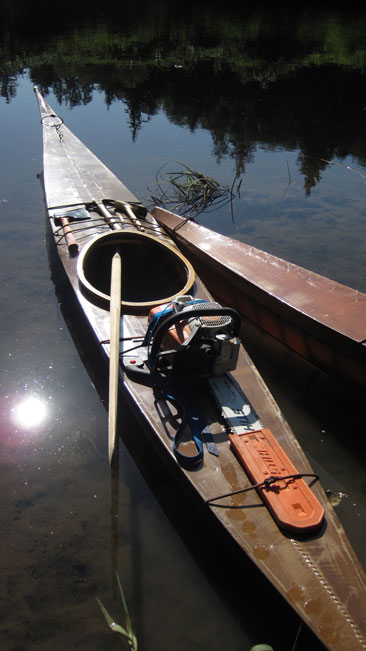
Fifteen minutes later we were pushing our kayaks down the muddy bank and into the north fork Nehalem river a mile from my house. Here you will notice the conspicuous presence of a non-approved motorized tool. I reasoned that it was insane to try to cut the hard locust underwater by hand, although I'm not sure how I thought I would reach the wood, seeing as we could not reach down to it with chainsaws before.
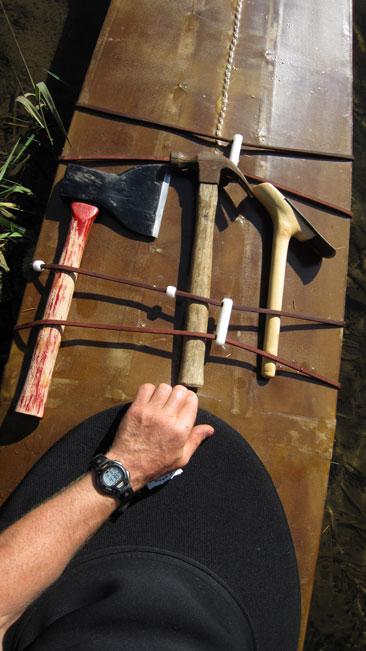
I'm more proud of the tools on my foredeck.

We headed down the shallow narrow river, chopping at random protruding sticks, usually with little idea what they were even after hacking into them. My memory of where Mark and I found the locust was pretty hazy, and things move a lot in a few years. I floated over a suberged limb-end of about the right diameter and reached over the gunwale with my handsaw to cut out a small wedge underwater. I pulled it up and noticed extremely tight growth in the tiny wedge. I called Tom over, "I think this is it!"
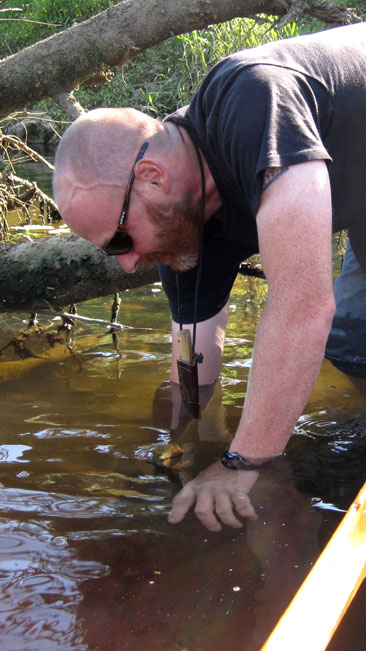
This is my karmic punishment for even thinking about using the chainsaw. The other end of the limb was deep underwater leaving little choice but to reach down with the hand saw. I expected it to be a simple procedure...
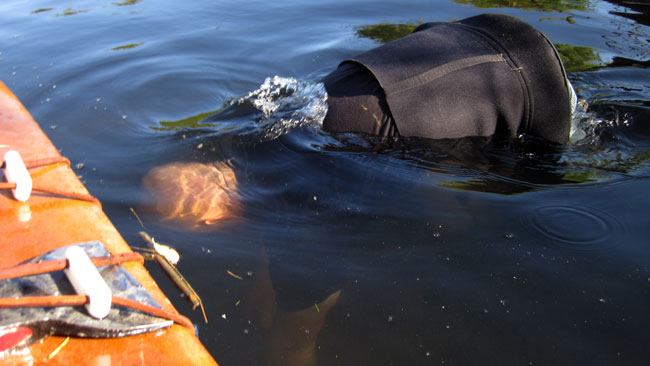
...and I was wrong. The limb made a deep arc down into the water and protruding straight down from the center of that arc were two strong side branches that held the log firmly underwater even with both end of it cut through. I had no choice but to dive down and saw furiously at the limbs while holding my breath.
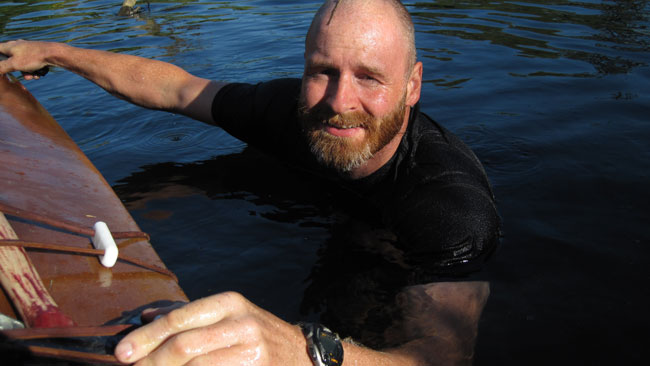
Coming up for air, the water is not warm.
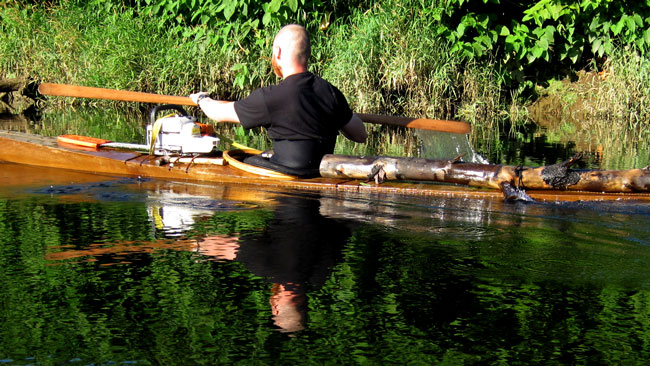
Once liberated the locust sunk like a rock and we were wise to have a rope on it. I dragged it ashore to cut the limb in half. We strapped the heavy half to Toms F1 and the lighter half to my greenland kayak, still, the fifty pound limb nearly submerged my back deck.
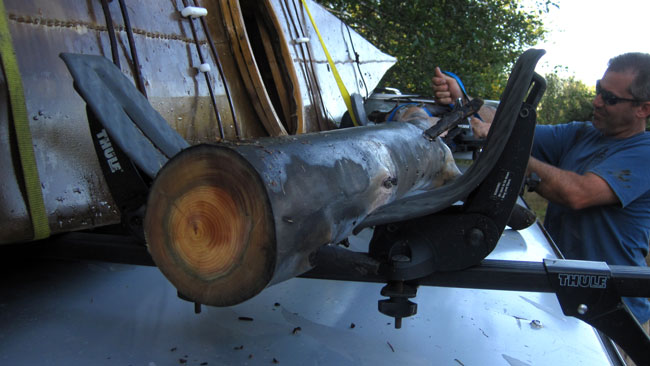
Tom strapped the limbs onto the car while I shivered and dripped water in my blue jeans and t-shirt. Tomorrow we'll find out if the locust was worth the effort.
Day 5
(the day I crashed my truck into the grocery store)
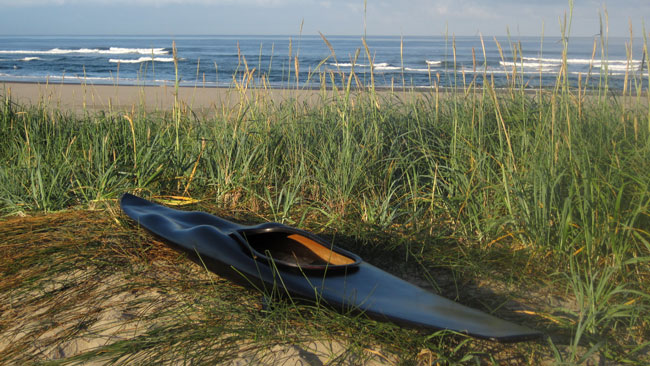
I woke up early this morning to get in a surf session in the freshly modified 'bat boat'.
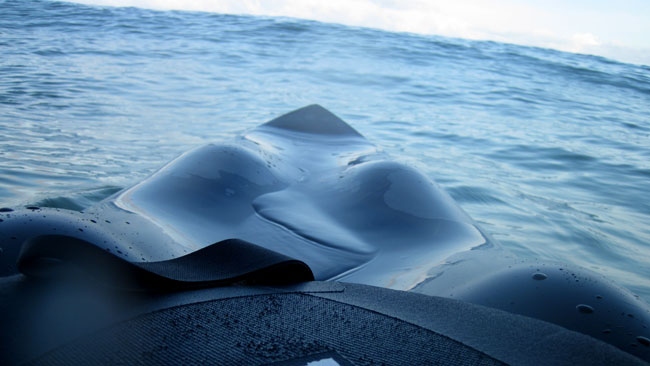
There was a decent swell but it just didn't clean up, leaving me hunting for peaks and dropping in where I could. Still, it was a gorgeous morning and I was pleased with the bow and fin changes on the boat. I drove the 'death mobile' (our farm beater truck) through town still dripping in my wetsuit, stopping to spray off my feet outside a local shop.
Then it happened.
I glanced back in horror just in time to see my truck roll out of it's parking space and backwards down the hill. I forgot that the parking brake doesn't work on the death mobile. I futily gave chase as the truck crossed both lanes and gathered speed as it headed straight for the local grocery store. Barely missing a square collision with the corner of the building it rode up onto the sidewalk and rasped it's way across the storefront siding, annihilating two sitting benches, three planters, a garbage can, and an entire display of watermelons before lodging firmly in the front doorway. Amidst the formidable carnage of splintered wood, potting soil, and red watermelon chunks I looked directly across the bed of my pickup at the Asian store owner now blocked inside. What does one say at times like these?
"I'm really sorry I crashed into your store Chung."
What else can you say? To make the story short, I agreed to fix any damage and Chung agreed not to have me arrested, and about a hundred rubbernecking tourists took the personal liberty to tell me how lucky I was in a condescending tone that seemed to imply that they dissaproved of red-bearded bald men in wetsuits driving beater cars in their holiday town, my town.
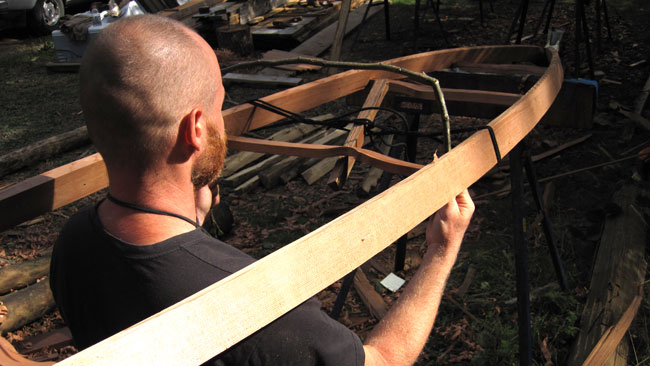
Glad to be back at the farm I started the workday with a green alder branch to determine an appropriate length for the longest rib.
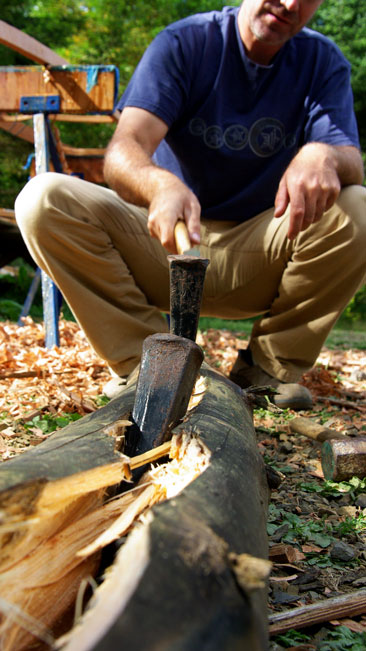
We cut both the wet and the dry locust into shorter lengths and Tom split those lengths again and again to make staves from which to carve ribs.
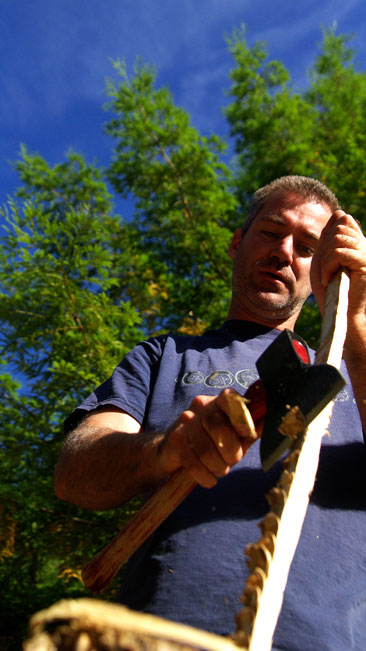
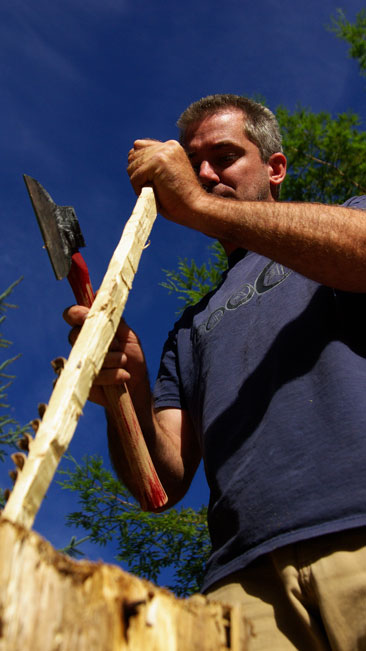
The locust resisted our work the entire way, but Tom was persistant and spent the entire day roughing out ribs....
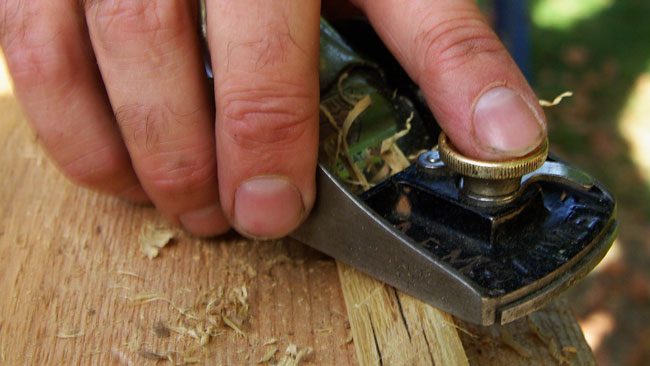
...and planing them down to oval shapes.
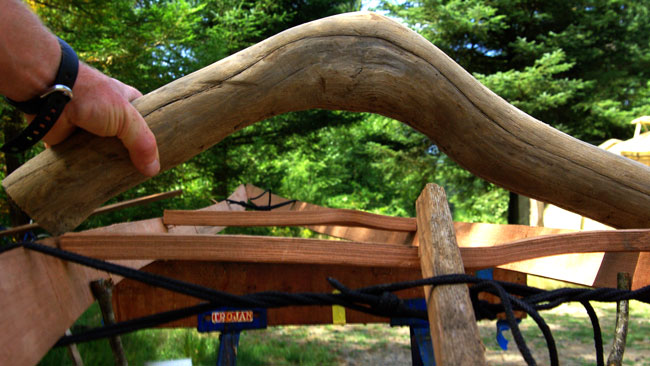
I occupied my day by slowly turning this crook into a masik.
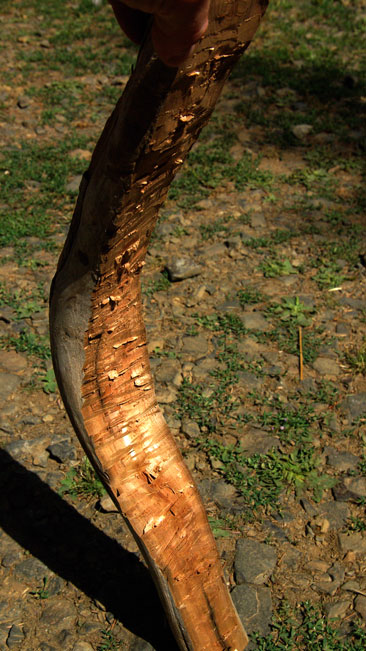
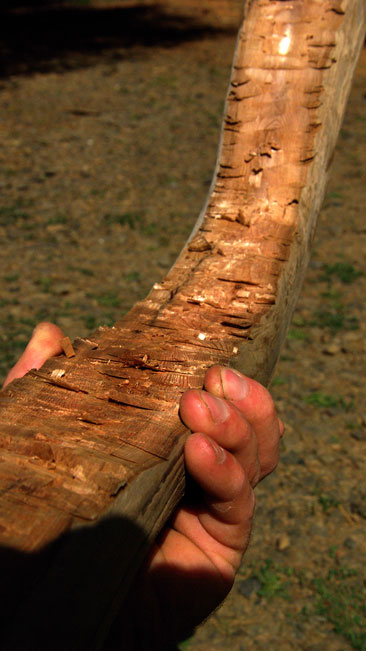
Hewing the masik was surprisingly tough work as I learned control with the broad axe and hand adze. The crook had a lot of cracking and wild grain and one bad blow with the axe would be enough to ruin it. I learned to use the small adze with a quick pecking motion which worked quite well. Finally I planed the masik smooth and scraped the convex surface as smooth as I could.
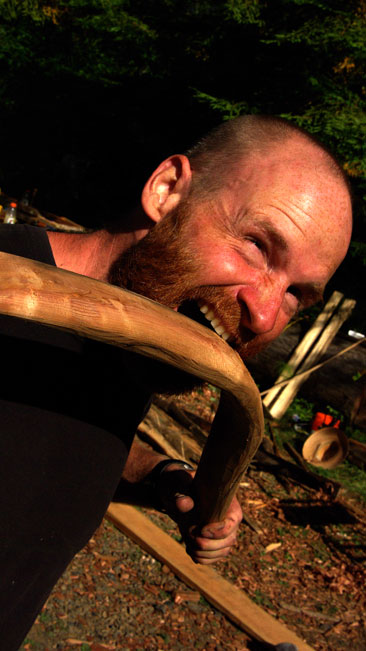
Standing knee deep in chips one starts to feel like a beaver.
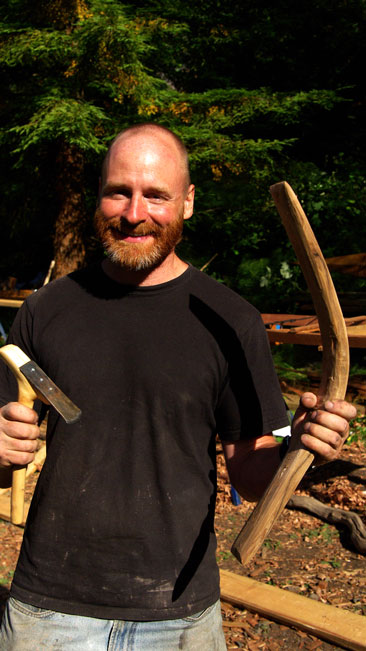
The finished masik, it only took me six hours!
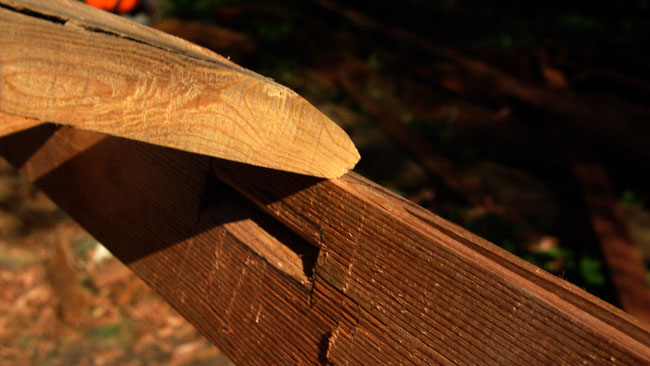
I gouged out a small blind mortise for the masik with my pocket knife and shaped the end accordingly.
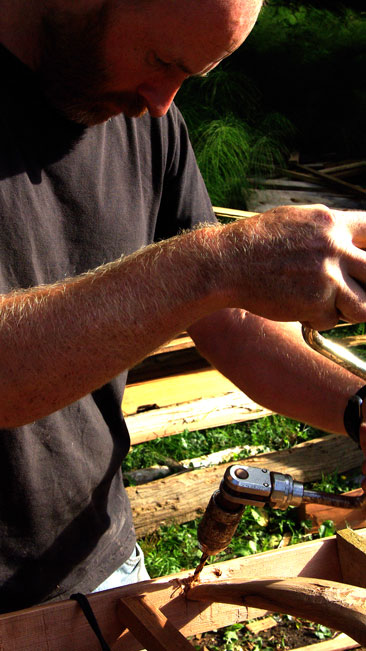
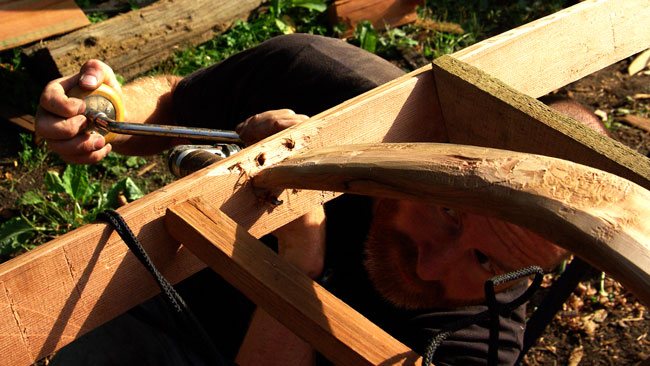
Drilling holes for the masik lashing.
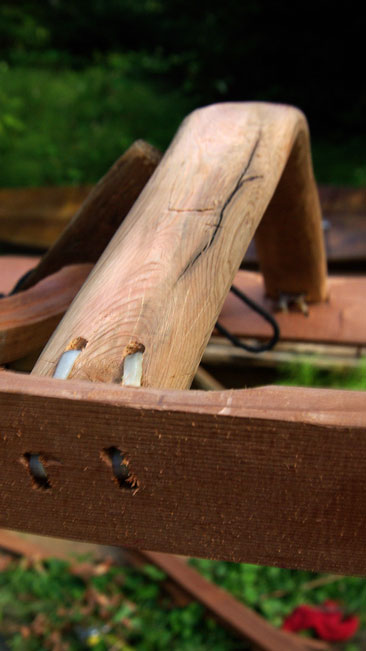
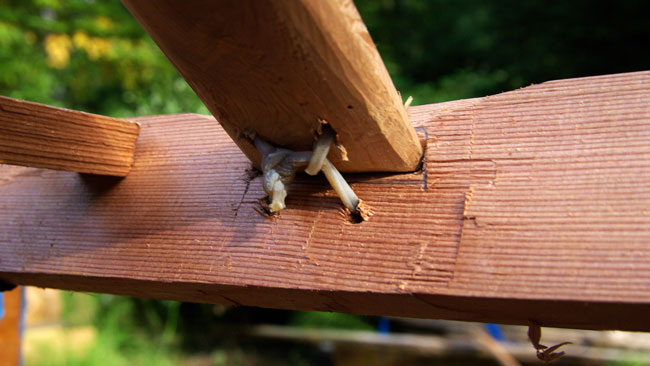
The masik is lashed in place with deer hide lacing crafted by my friend Patrick. The lacing is amazingly even considering that it is spiral cut in long lengths from a single hide. The masik joint, the holes, and the lashing pattern are all taken directly from an excellent drawing in Eugene Arimas study: Notes on the Kayak and it's Equipment at Ivuyivik, 1961.
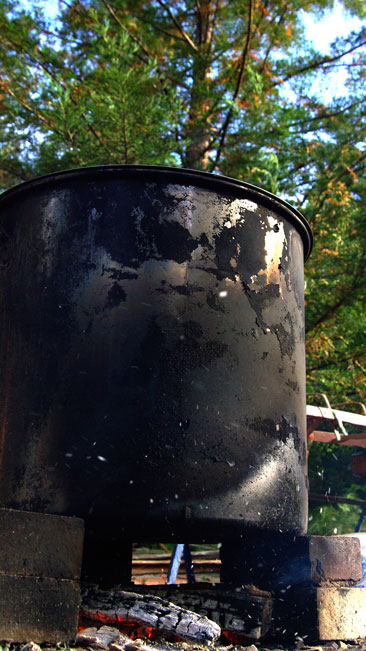
Meanwhile Tom has been boiling test ribs from both the dry and the wet locust in this 20 gallon pot set over an open fire in the driveway and fed with wood from our work.
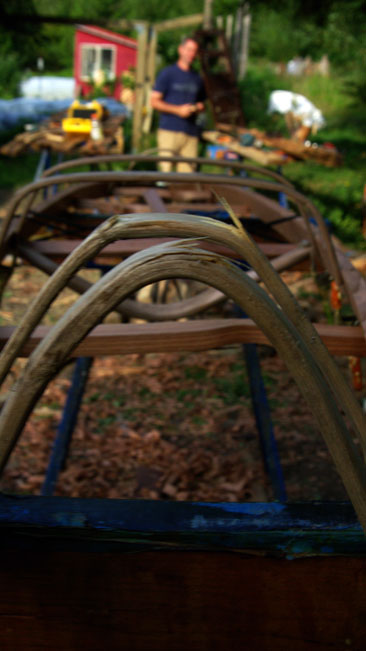
The dry locust bent surprisingly well and looked a lot like what we saw in photos of the original kayaks, broken, but not entirely.
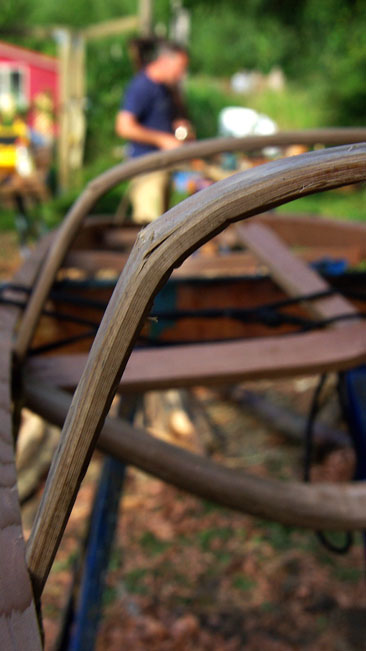
The wet locust bent almost too well and I had to really force it to get it to crack. This sharp turn in the bilge is intentionally very abrupt. One masik and twelve ribs, (we test bent 5), not much work for two guys working an entire day.
Day 6
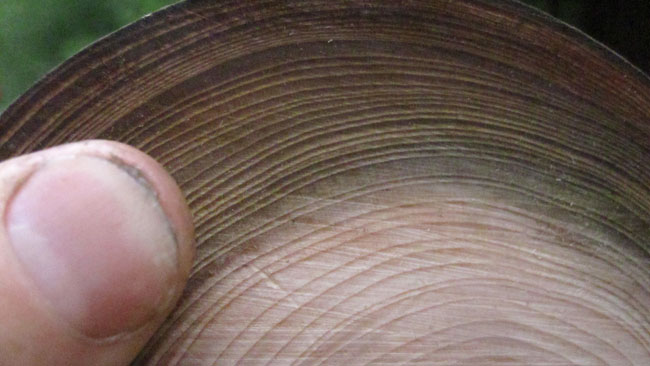
I began the day doing some shaping on the gunwales, while Tom worked on making ribs for the kayak. The locust proved incredibly tough to work and eight straight hours of hewing ribs definately took it's on his hands. Above you can see the incredibly tight grain of the limbs Tom was working on.
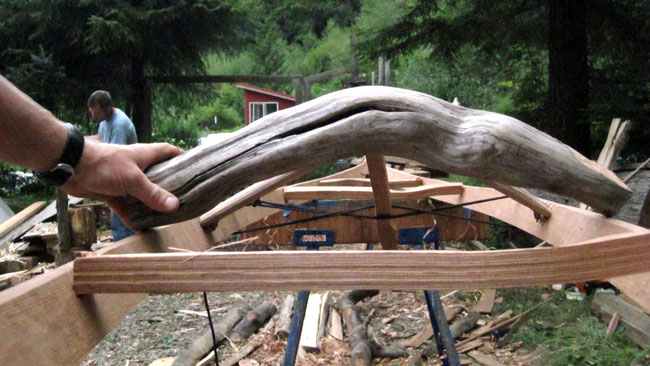
I also pretty much did the same thing I did the day before.
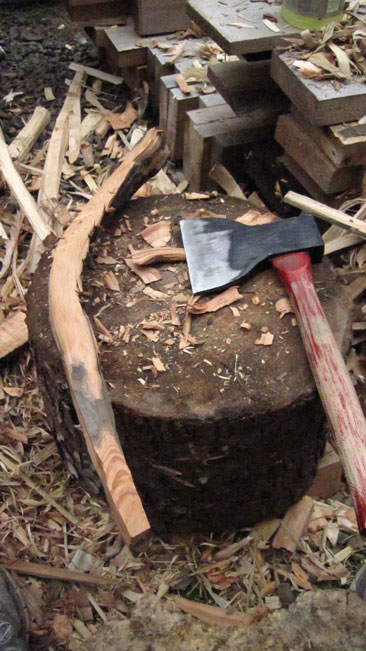
Roughing out curved deck beam number two.
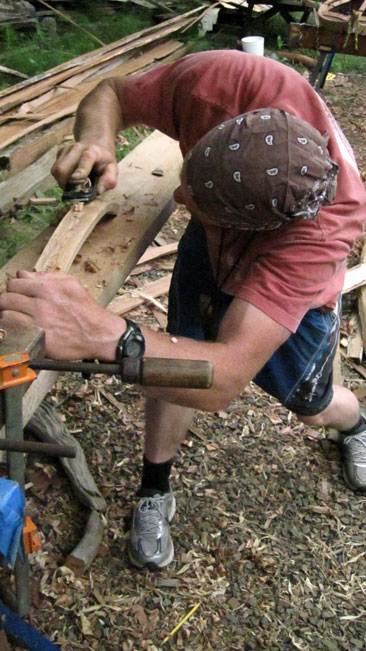
Planing the curved deck beam. This one only took me 3 hours to build, twice as fast as yesterday!
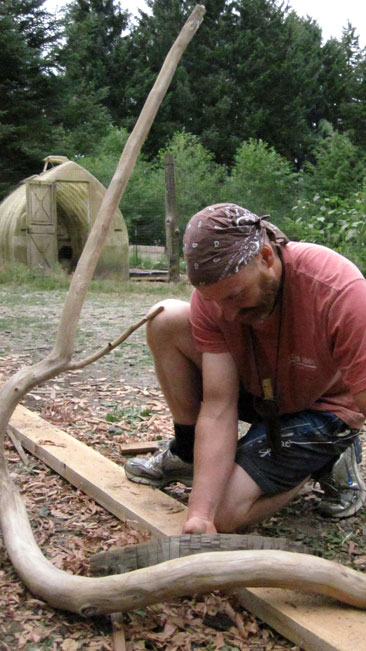
After rough hewing the third deck beam it split and I had to discard it and search out a replacement crook. I found this wildly curving dry branch that contained any number of radiuses on it's 3 dimensional curves.
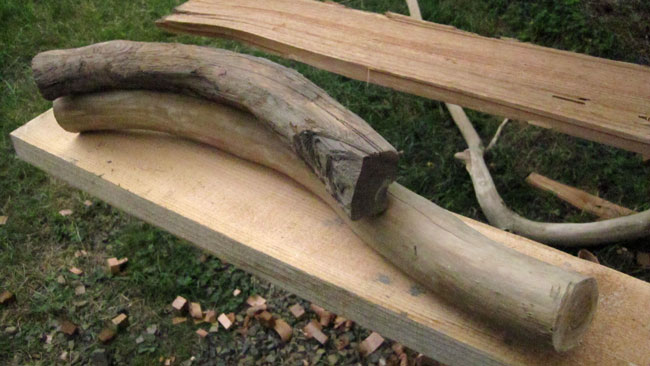
Matching the curve from the split piece.
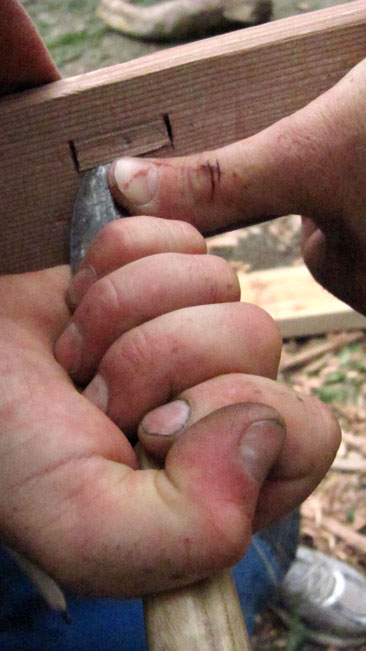
I cut the blind mortises by hand with a sharp knife, it was both easier and faster than using a drill. After the masik position was scaled from the drawing and marked, I marked the rest of the deck beams using only my hand to measure and cut all the mortises by eye.
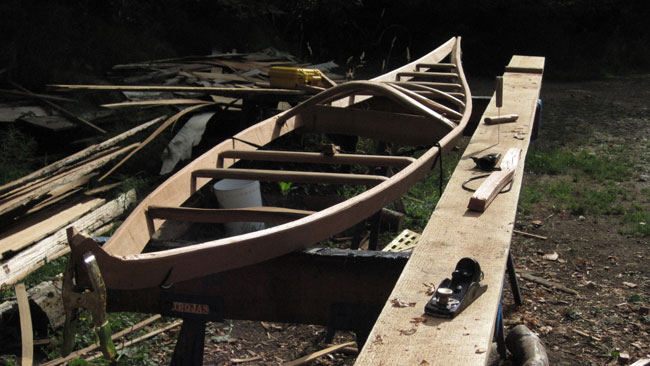
Both Tom and I are professional woodworkers and by the end of this day our hands hurt! Still two deck beams shy of what I had hoped, everything on this project takes longer than I expected. I hoped to have the deck finished today but it will likely take until the end of tomorrow.
Day 7
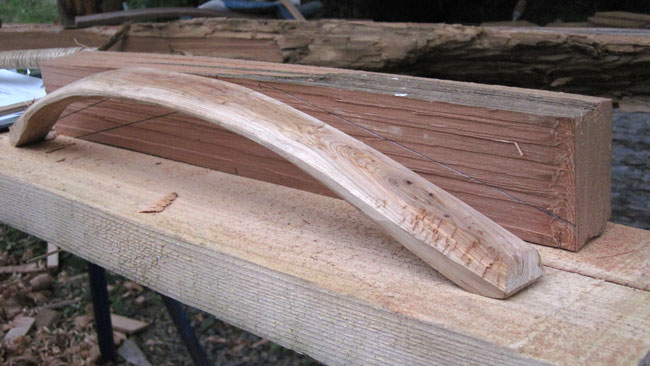
I woke up early this morning and started by pulling out the deck beam I'd replaced yesterday and replacing it again because the curve wasn't right. I carved this last beam out of a solid block of split cedar.
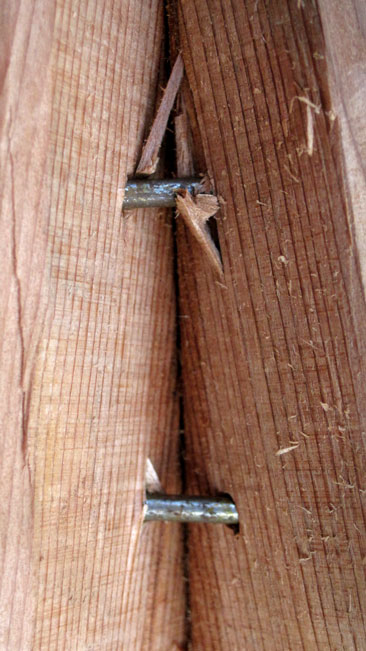
As per the original, I nailed the ends of the gunwales together once I finished placing all the deck beams.
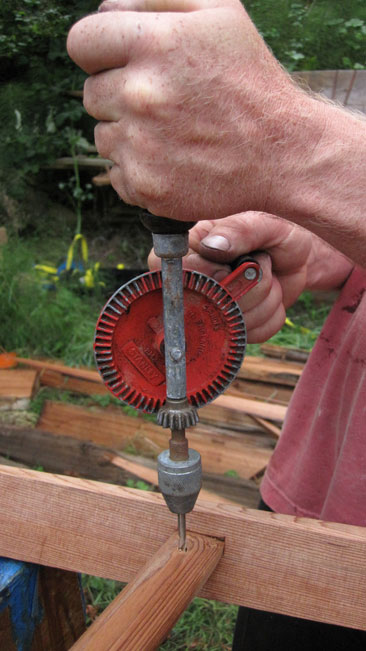
Satisfied with the finished deck beams I started drilling holes for lashing. This small stanley eggbeater drill was frustrating to use.
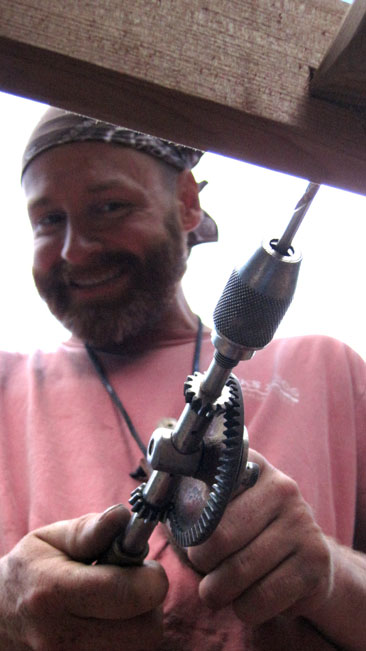
Noticing my frustration Tom loaned me his grandfathers old eggbeater and the difference was like night and day, it drilled quickly and smoothly.
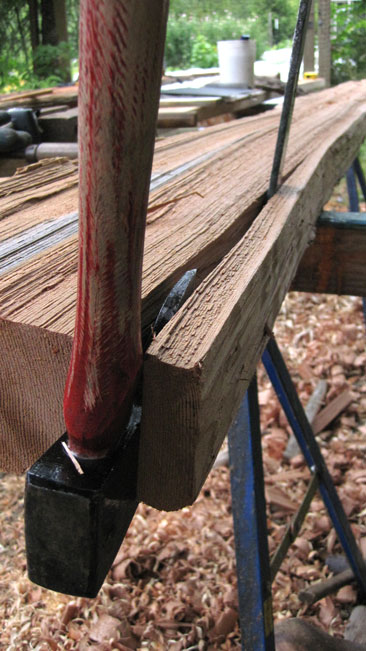
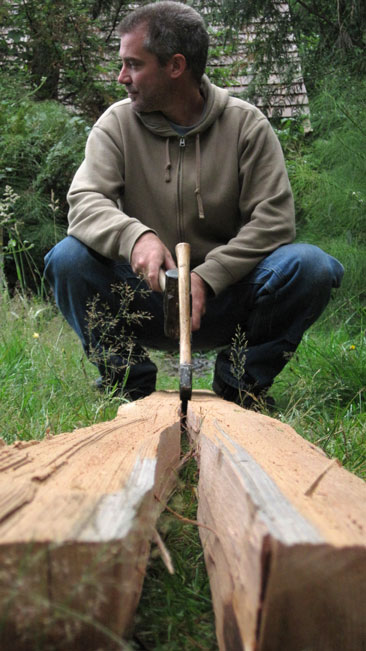
Meanwhile Tom split out wood for the stringers.
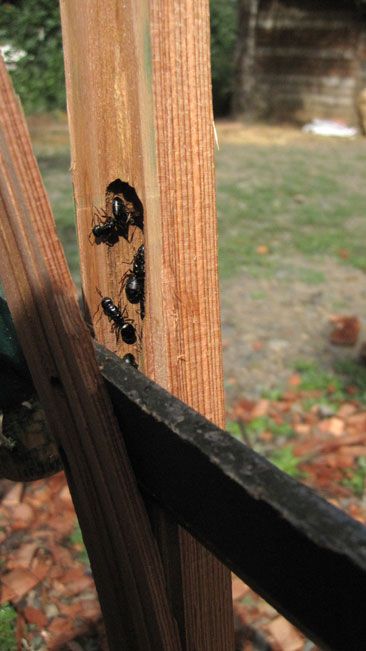
Suddenly Tom yells, "Hey, you gotta see this!" Tom had split right into a hidden pocket of black ants!
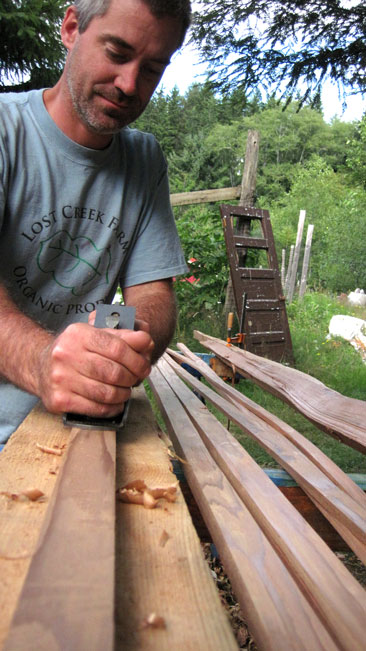
Tom planes the stringers.
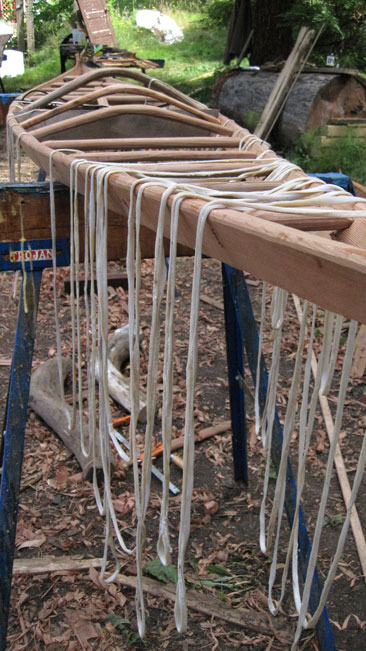
I untangled a one hundred foot continuous piece of wet deer hide lacing to get ready for the deck lashings.
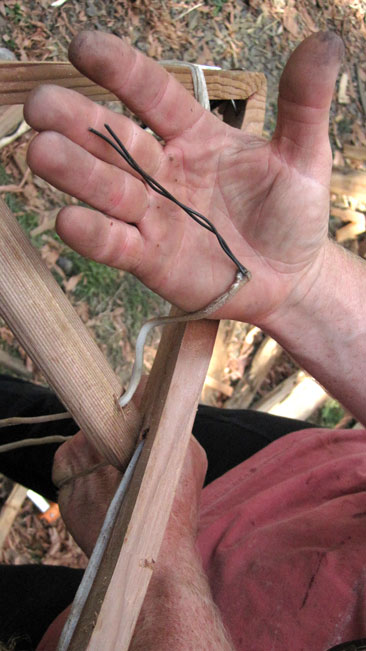
I used a scrap of tie wire as a needle to thread the continous deck lashings.
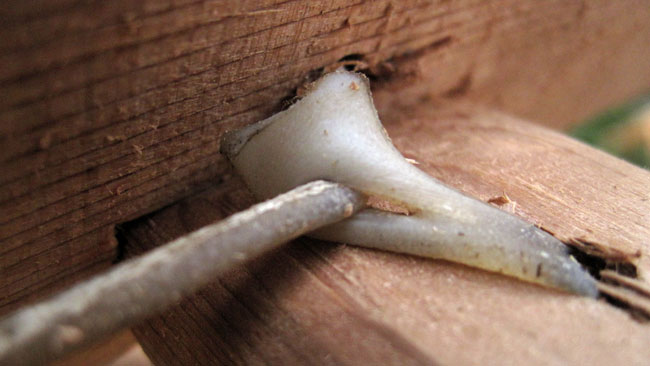
The beginning of the lashing.
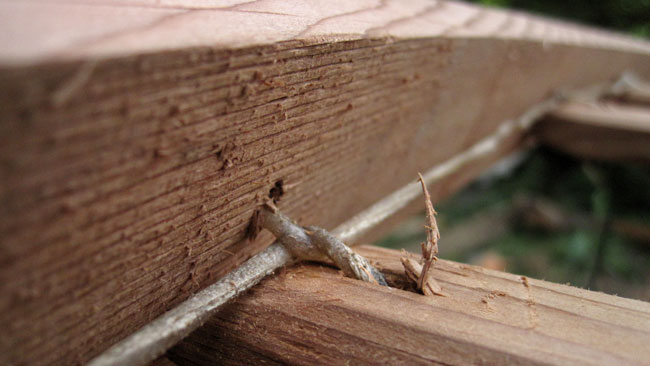
Continous deck beam lashings pull the deck beams into the blind mortises.
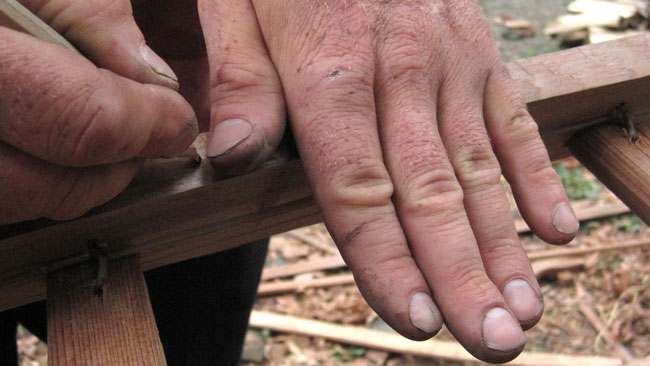
With the deck tied I started marking for the rib mortises. I chose a hand measurement of roughly 3/4 the original hand measurment.
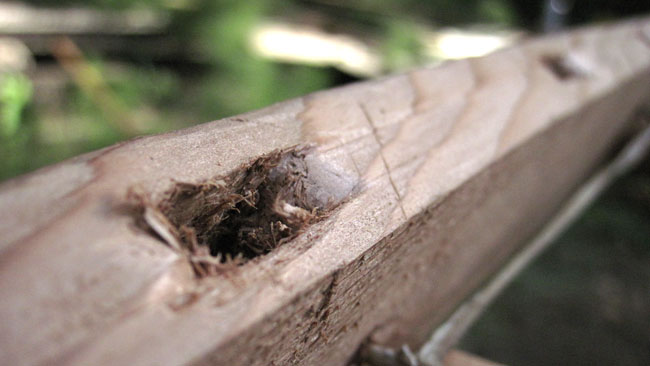
Mortises were drilled with a bit and brace and roughly chopped out with a chisel.
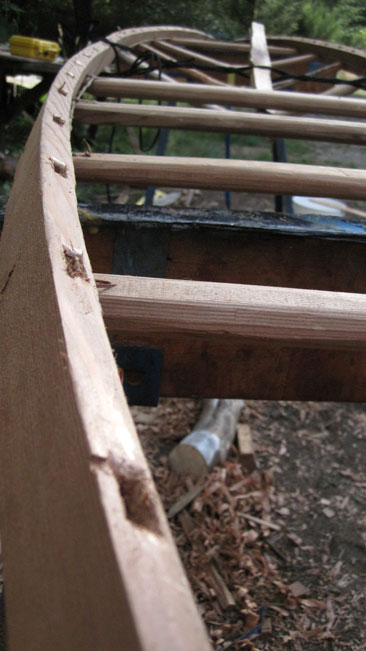
Deck beams and mortises at the end of the day. Good progress.
Day 8
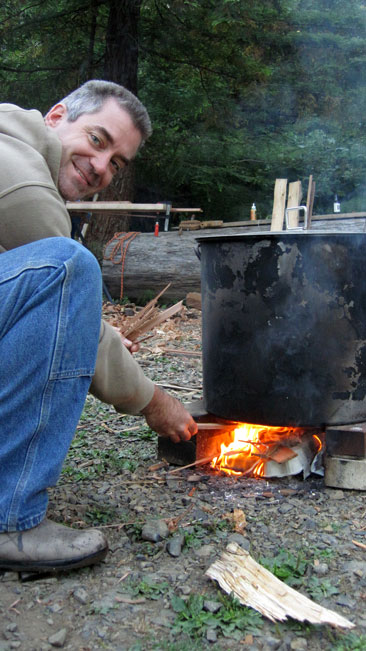
First thing in the morning Tom lit the fire, it takes a long time to heat up 20 gallons of water.
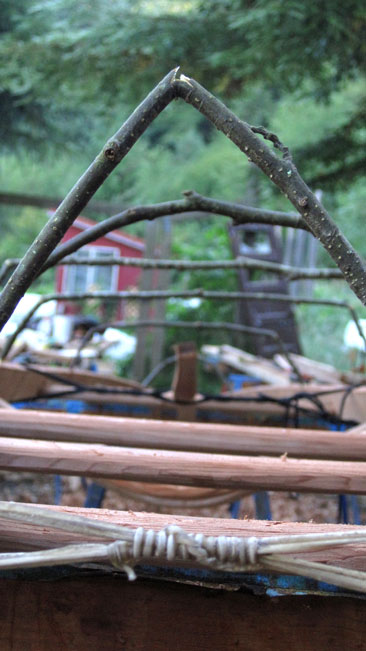
Although the original guys would have bent the ribs in by eye while steaming, I chose to mock up a few of the ribs with twigs first to get an idea of what lengths we would need. I discovered that a simple hand measurement would suffice to get approximate lengths for the finished ribs.
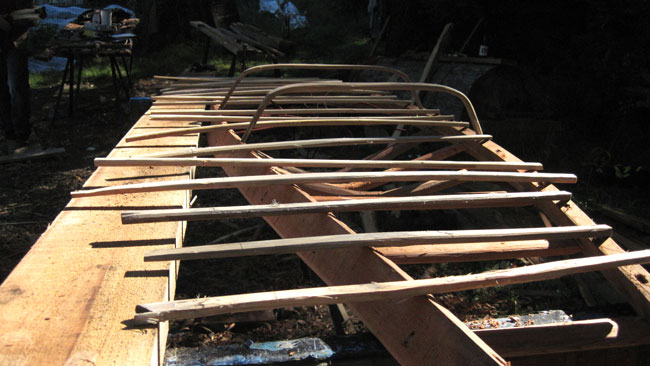
The ribs are a mixture of wet and dry locust, hewn down to size.
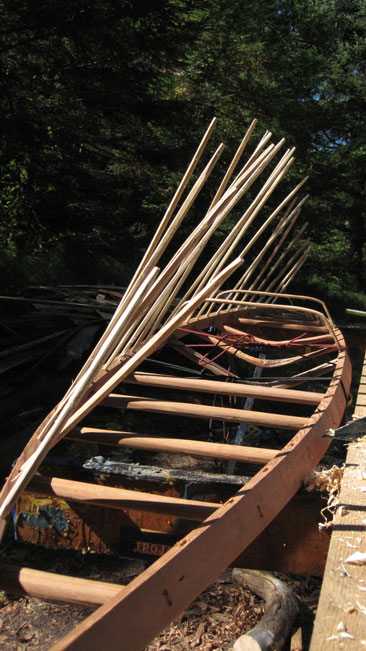
I precut the rib stock to approximate lengths and installed a few of our test ribs from yesterday.
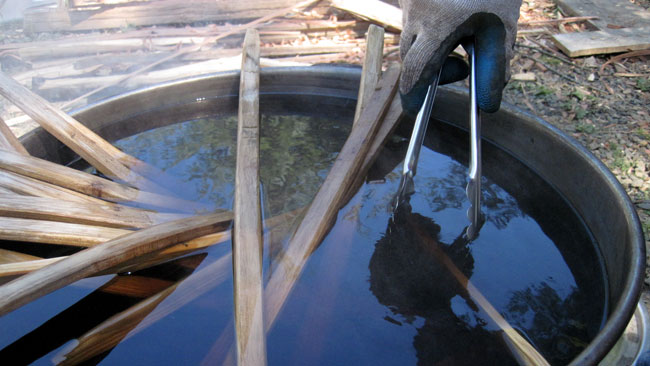
We boiled the ribs in the pot for a few hours before Tom pulled them out one by one.
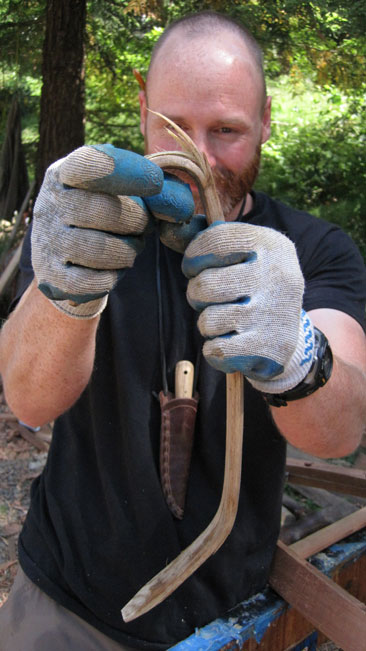
This may look hideous, but it is exactly what we were supposed to do. This is probably the most extreme case, but still an entirely usable ribs with most of the bent wood still intact. Most of the ribs on the originals were broken worse than this one is.
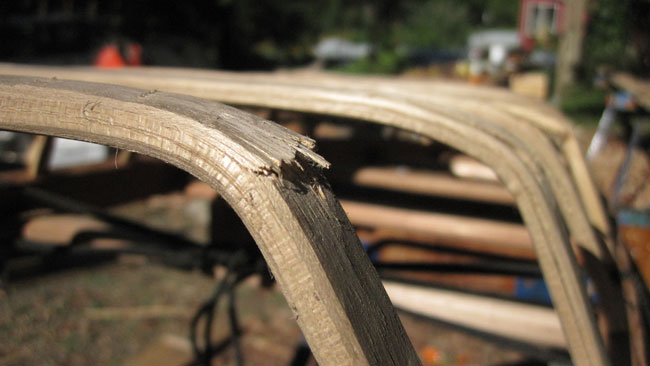
This is probably ideal, providing a hard turn at the bilge with not too much splitting.
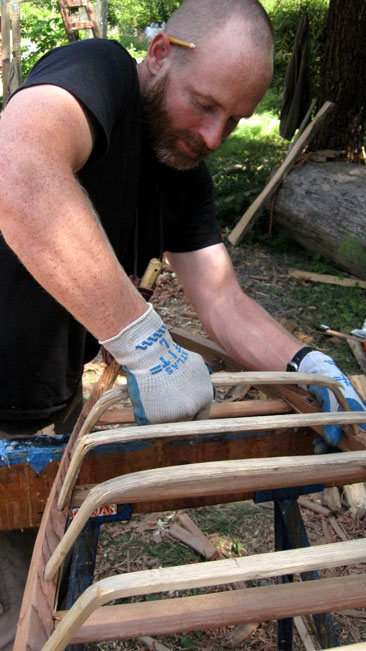
Bending in the ribs.
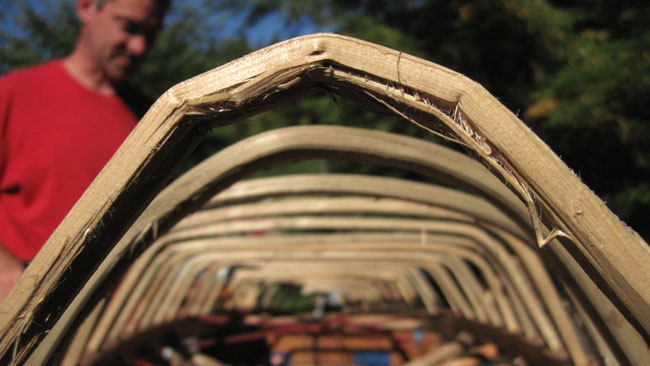
After bending in the ribs I made extensive use of the saw to trim the ribs down to get a fair shape.
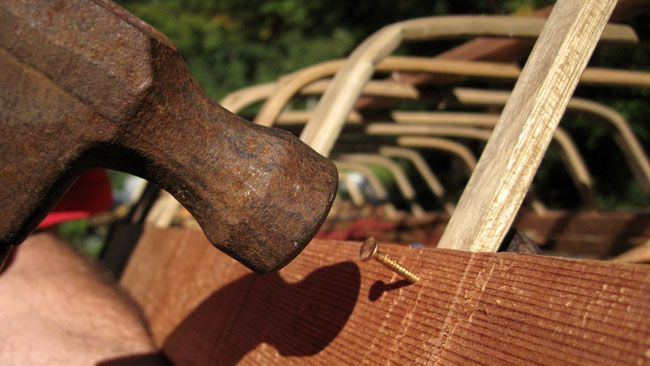
Rather than go and try to find some rusted nails to make things look 'authentic' I grabbed some bronze nails from the shop and Tom nailed in the ribs as per the original we are copying.
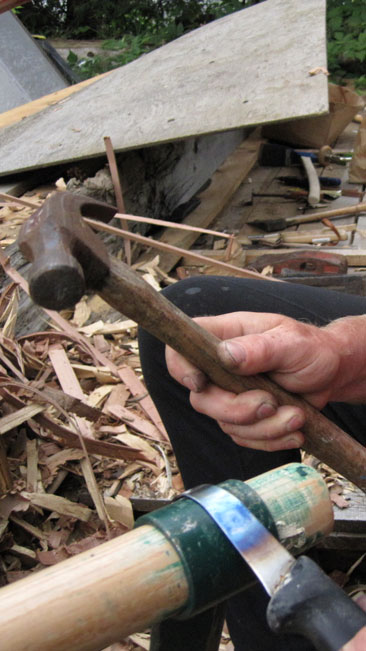
The stringers on these boats were almost always hollowed out to wrap over the curve of the ribs and hide the broken sections. We pondered for a while on how to cut this hollow and finally decided to try to make a curved knife. I grabbed a knife from my kitchen and heated it with a propane torch, using the back of the froe to pound it to shape.
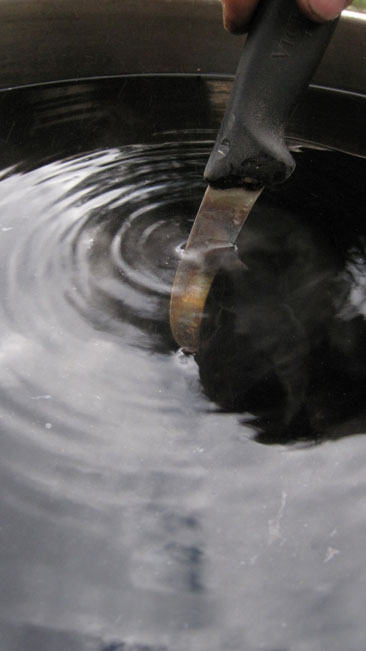
We quenched it in the rib boiling pot and decided it didn't feel too brittle so Tom put an edge on it and we gave it a go.
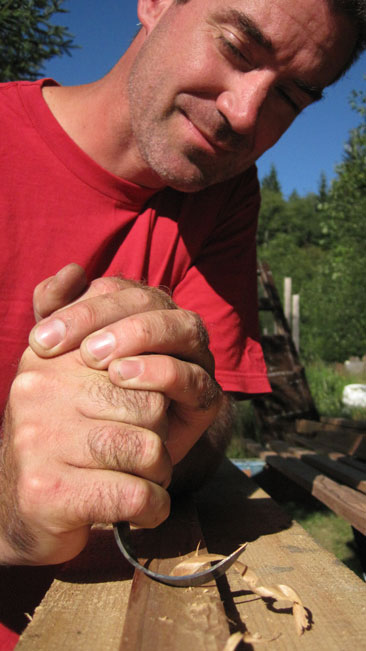
Success! not ideal but it does the job.
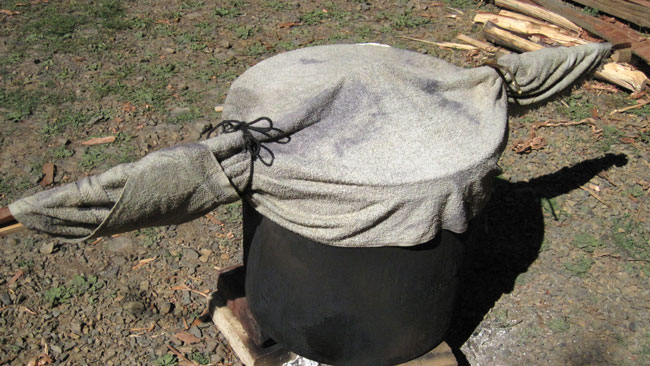
Our final task for the day was to bend the coaming from a two-inch by half-inch dry locust piece that Tom hewed earlier in the day. We draped a towel over the ends to get the steam across the entire lengh.
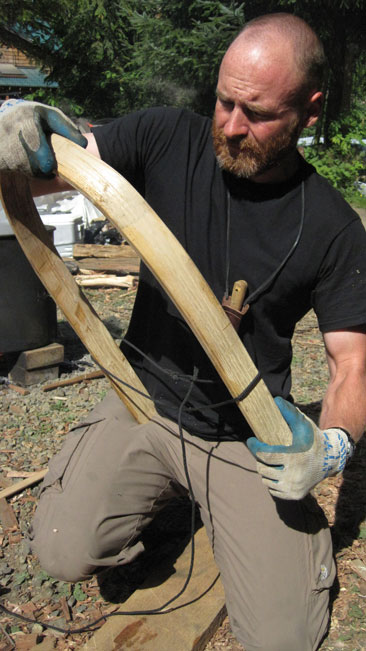
Bending the curved part of the two-piece coaming was very difficult and we re-boiled it six or seven times to try and get the shape right.
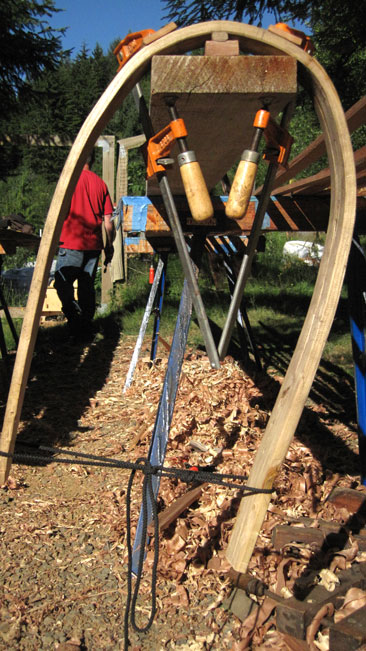
Eventually we broke down and pulled out some clamps to force a better shape.
Day 9
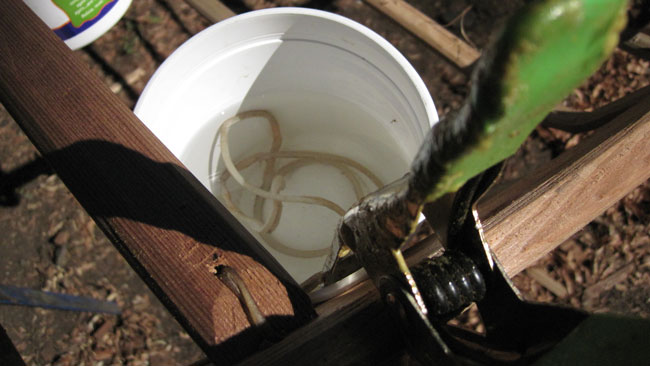
Yesterday evening Tom and I looked at the lines of the completed deck and decided that, although within historic variation, the masik and curved deck beams were too obtrusive looking. So first thing this morning we cut the lashings and removed ALL the curved deck beams to replace them with new ones of a lower (but still within historic variation) profile. Here you see the cut lashings soaking in water so they can be reused to lash the new beams in place.
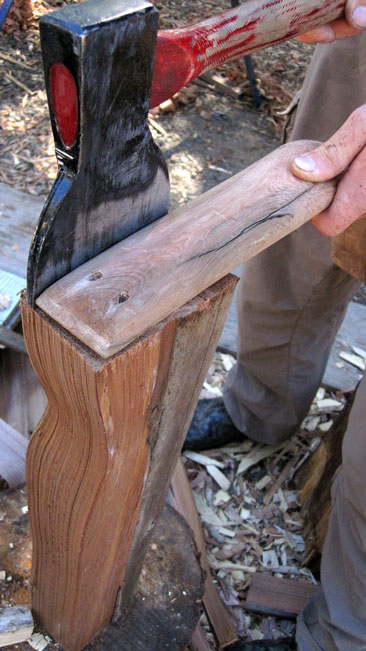
Having already cut our teeth on natural crooks we chose to cut our replacements out of solid cedar blocks. With the grain oriented vertically this is more than strong enough and I would, (and have) use it in my own kayaks.
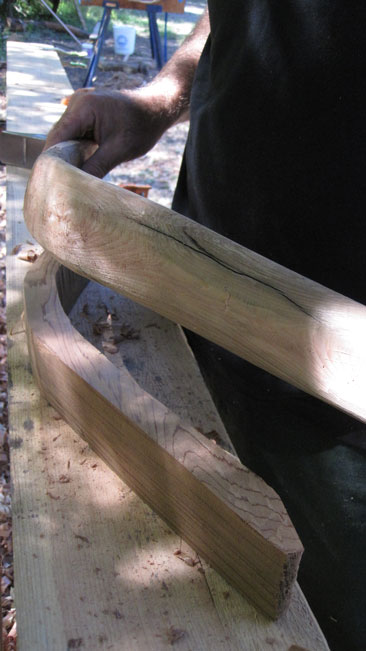
It was difficult to replace two days of hard work with new curves only slightly lower than the old ones, but not to do it and know I should have would have been worse. That said, I was still pretty cranky about losing a whole day.
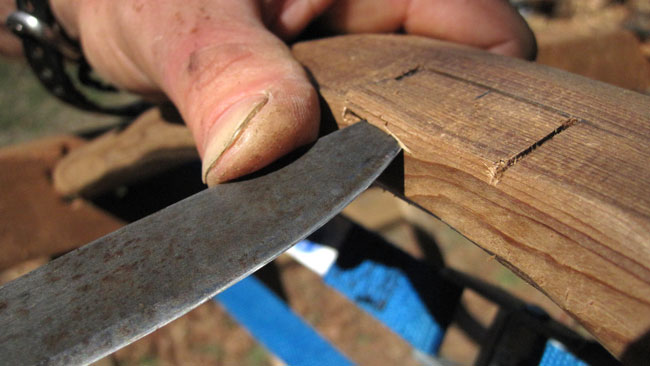
With the curved deck beams rebuilt and tied in we turned our attention to the deck stringers. A shallow mortise is cut in the deck beam to recieve the stringer.
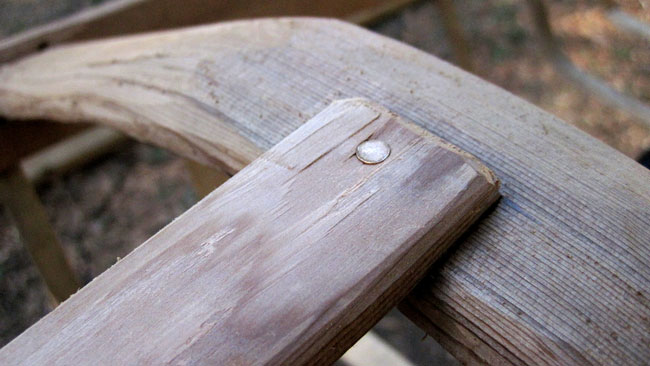
The stringer is fastened with a single nail. It could have been lashed, screwed, or left untouched.
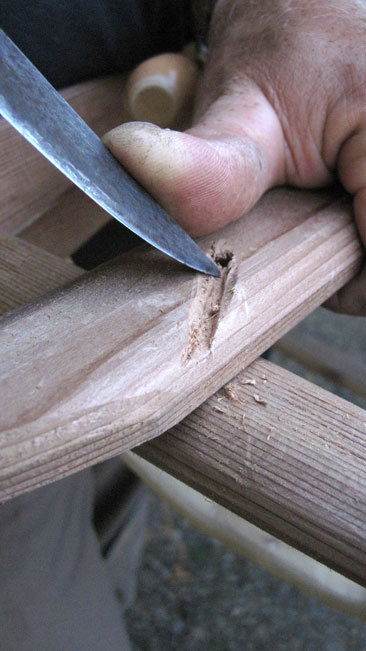
Holes are drilled and deep notches are cut for the continous deck lashings.
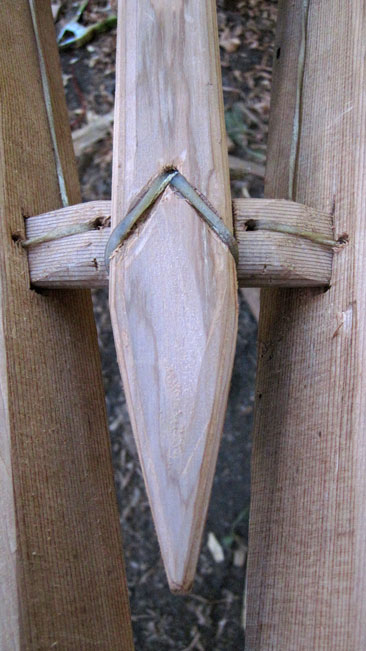
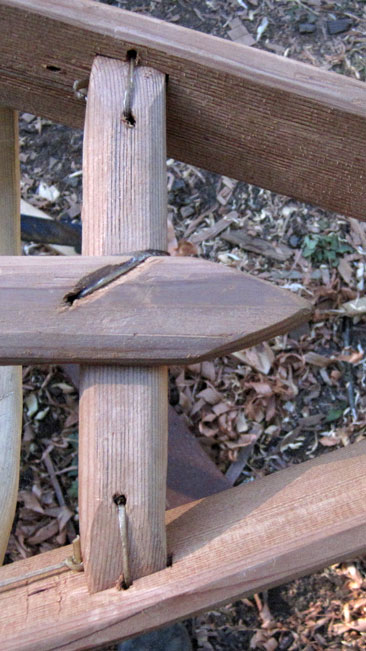
The terminus of the bow and stern deck stringers.
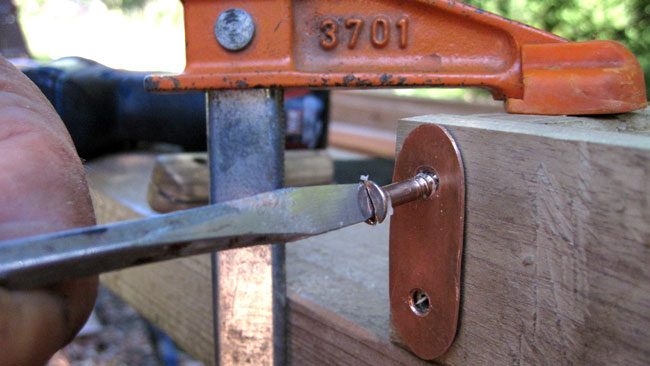
Next we worked more on the coaming. In Eugene Arimas study he mentions that in the rebuild of a kayak he documented, the native builder used a 'small oblong plate of copper, and one of antler' to back the screws used to fasten the straight piece of the D shaped coaming to the curved piece. The plates prevented splitting of the wood so close to the end grain. I fell in love with this small detail and although I could have copied any number of coamings constructed more simply, I chose to reproduce it for this kayak.
I fashioned a plate of copper by hammering an old piece of copper pipe flat and cutting the outline with tin snips, finishing it on a mill file. Here I must confess to using a power drill and a Fuller countersink to carefully pilot the hole. I simply don't have the experience to pilot this by hand and achieve predictible results, and the idea of a bronze screw broken off deep inside a piece of wood we spent two days building and had no stock to replace, was simply an unacceptable risk. The screws were waxed and driven by hand.
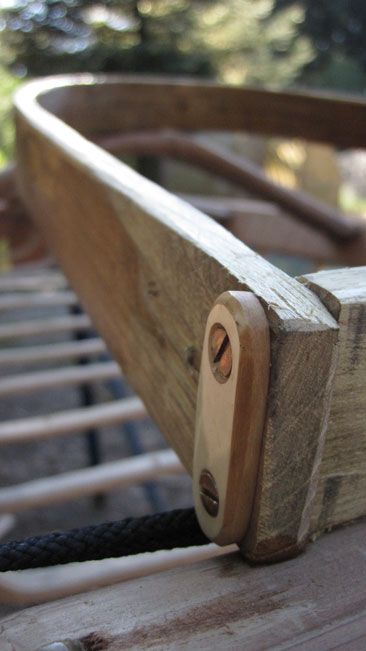
Our deer antlers are not hard like caribou antler, so I chose instead to make a thin ivory plate for the opposing side. This was cut from a small piece of a walrus tusk that a friend gave me six years ago. Again, having absolutely no clue how to cut and carve ivory by hand, I carefully used a band saw and edge sander to make this tiny plate.
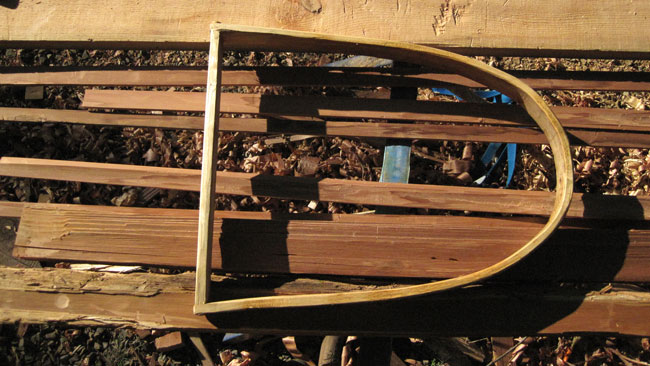
The completed coaming.
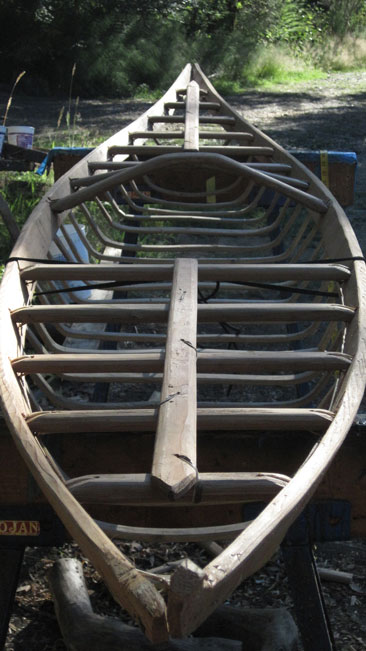
Our progress at the end of the day.
Day 10
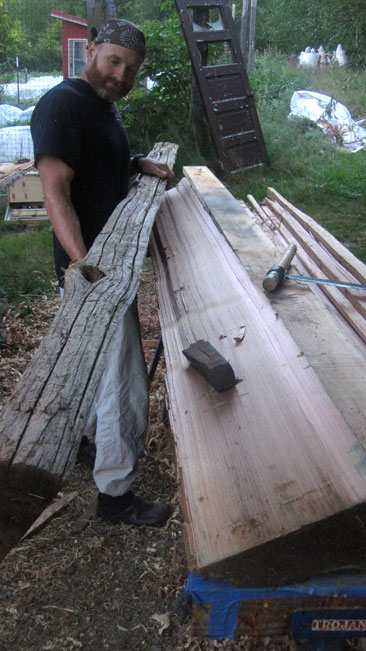
We started the morning by splitting out a blank for the paddle from an absolutely gorgeous piece of clear cedar.
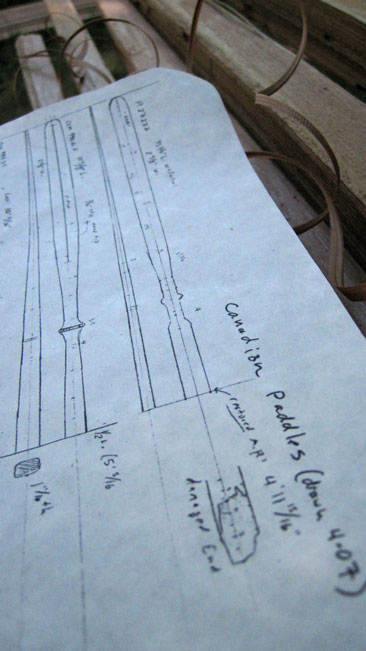
Harvey came through with a paddle survey for Tom and I to work from.
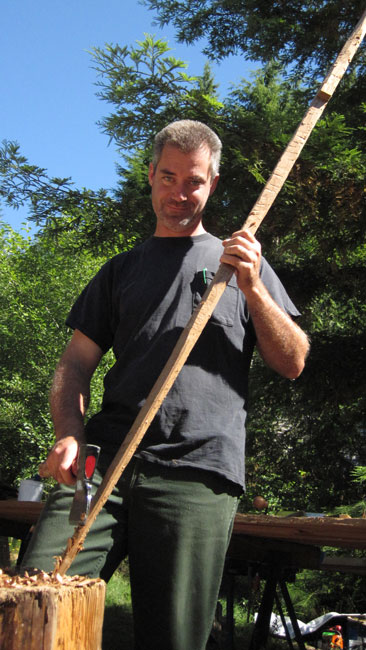
Tom in a common pose, hacking away with the broad axe.
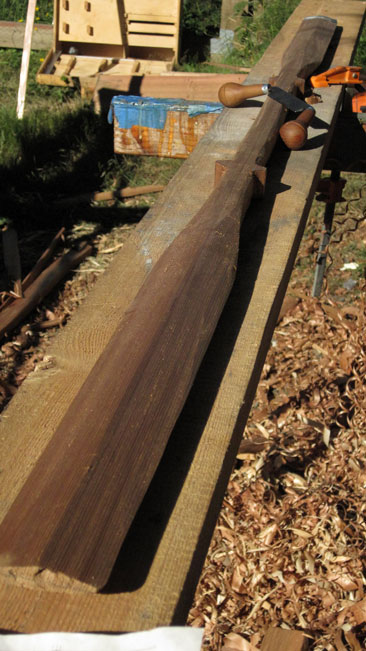
Tom spent the day carving the paddle.
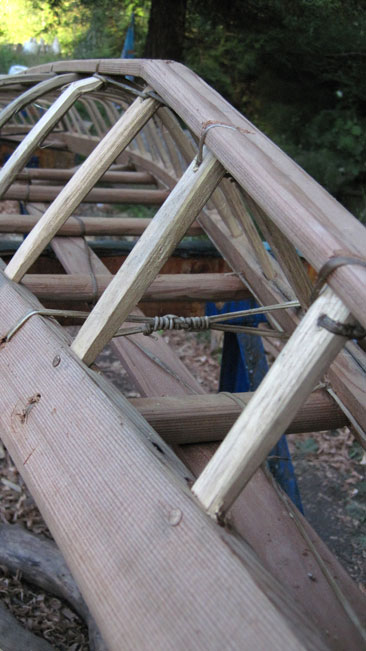
I pieced in the last ribs in the bow and started the keel lashing.
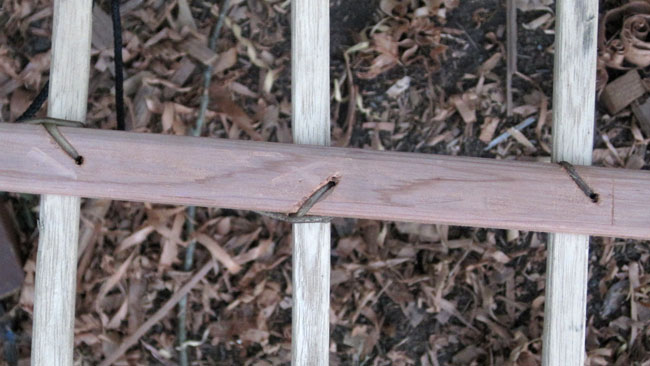
The lashing alternates and is let into grooves in the keel.
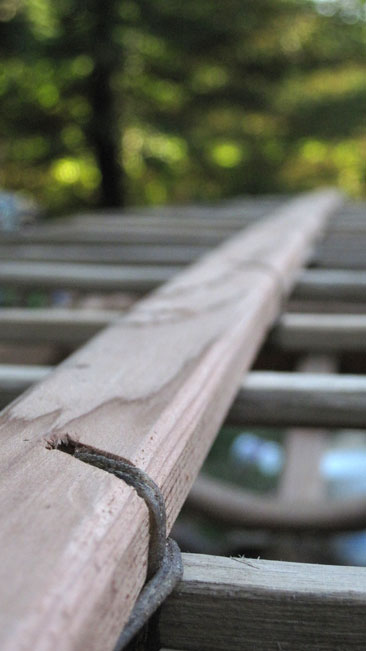
A close up of the lashing.
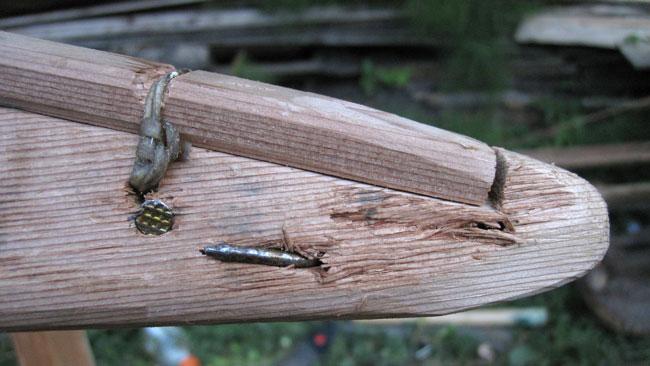
The keel is notched in at the bow and lashed down with a simple lashing.
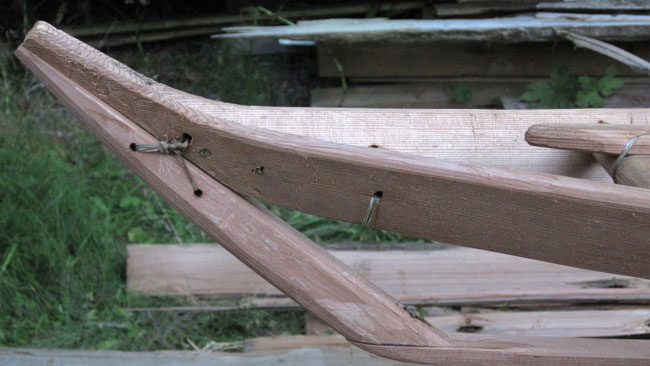
While the keel is normally bent up into the gunwales on most East Canadian kayaks, on the Belcher kayak we are copying a distinct stern post is visible and is referenced in the text. I attached it to the keel with a simple round lashing and to the gunwales with a V lashing. The V lashing is likely not correct but we had no details on how this was supposed to be tied.
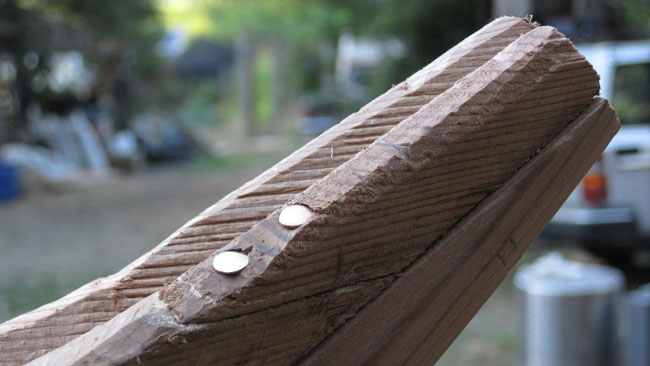
A small repair was neccessary when the fragile stern 'swoop' cracked.
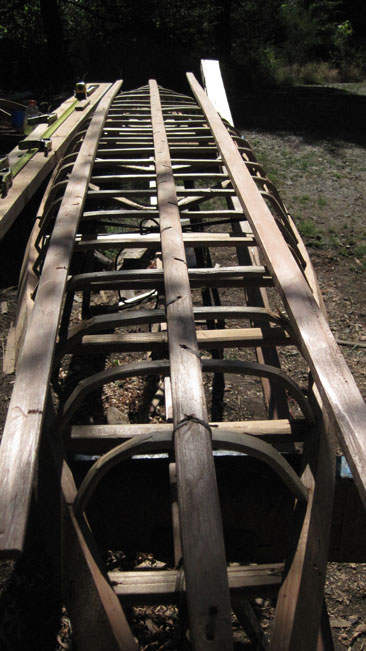
When it came time to lay on the stringers and lash them down it became horribly apparant that no amount of torturing would cause them to conform to the correct shape. After carefully scrutinizing the historic photos it was clear that these pieces must have been cut from curved stock and shaped into a curve as well. This is another place I could have 'cheaped out' and just lashed them down and not mentioned the discrepancy. After so much work already I could hardly do that though.
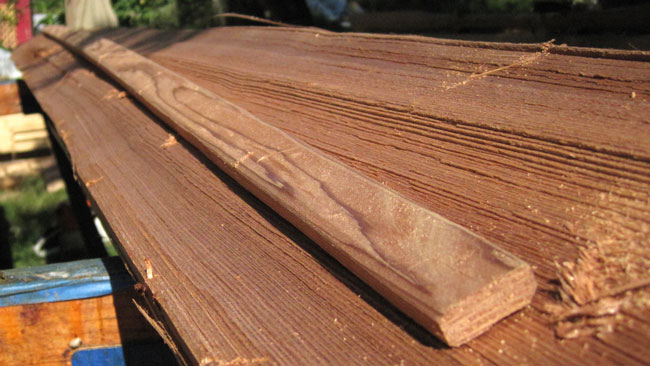
So we began the slow, painful process of hewing new CURVED stringers from rough split TWO BY EIGHTS.
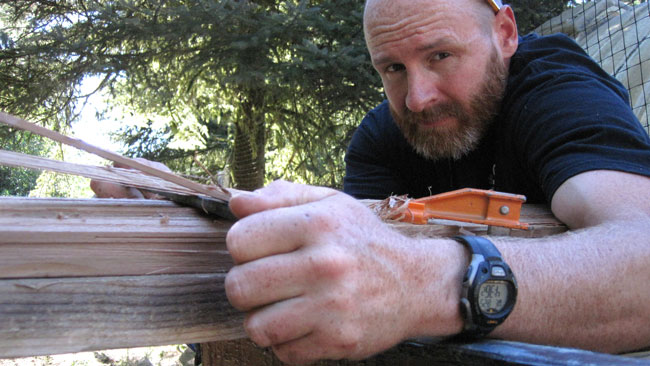
Not what I was hoping to be doing right now.
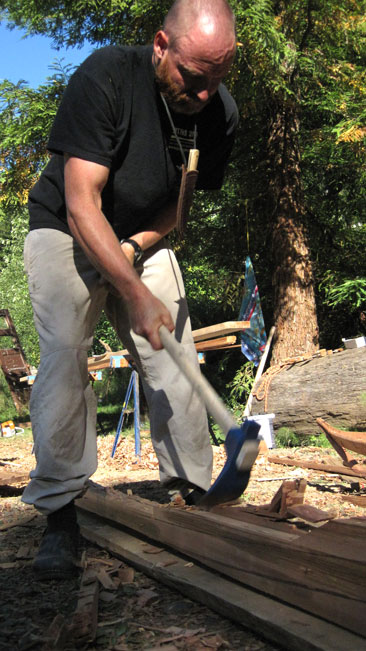
After flattening two surfaces the planks were nailed face to face with a curve drawn on them and I spent a somewhat violent twenty minutes chopping out the rough curve with the big adze.
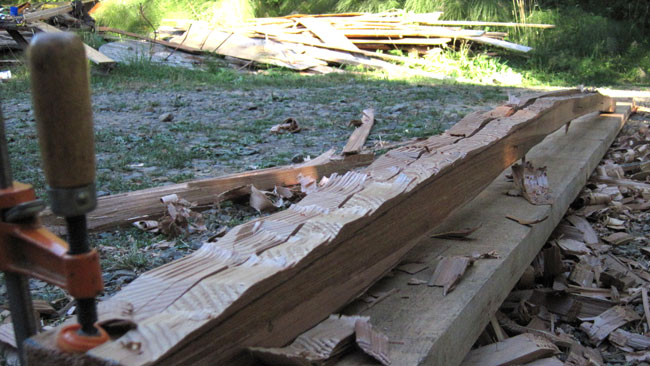
The rough curve.
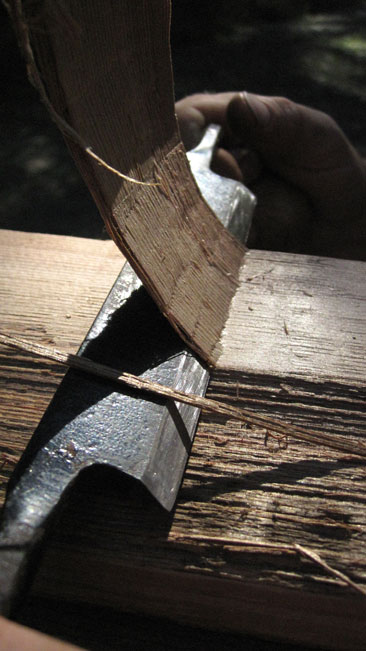
Further thinning with a draw knife.
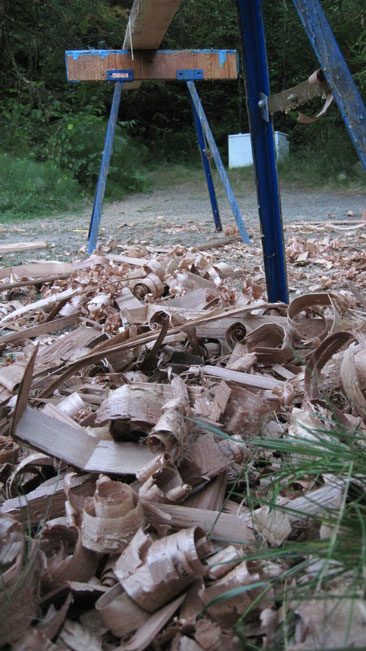
This entire mess is from shaping the stringers.
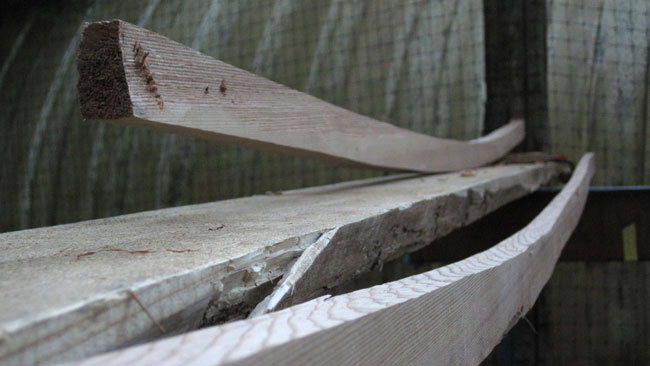
The nearly finished stringers at 8pm.
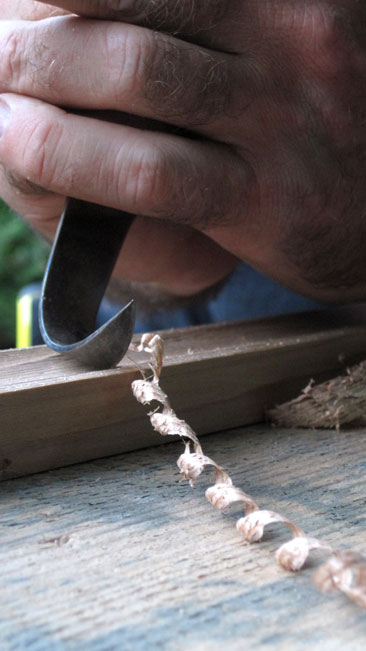
Tom cuts new hollows with our makeshift curved knife after a twelve hour day.
Day 11
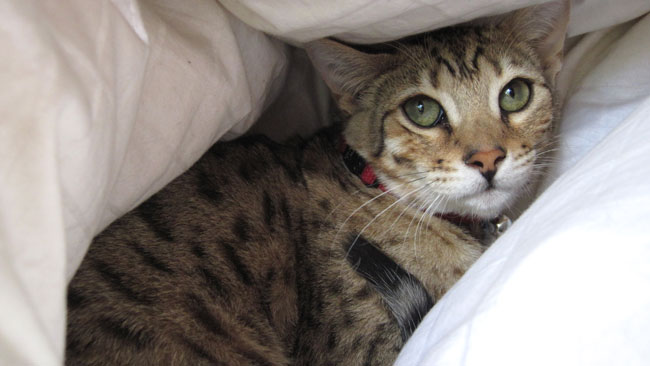
Every morning my very shy bengal kitten Spot takes a much hated trip to the main house to play with the other cats. In the usual routine I reached down to grab her by the scruff and oddly she slipped out of my hand. Incredulous, I tried again harder and again she slipped free. Ten days of hard lashing and hewing had reduced my aching digits to one of those loose robot claws that drops into stuffed animals at arcades. I settled for pinning her down with a towel and bundling her up. I needed to finish the boat today.
Tom and I worked non-stop all day long to finish the kayak, finishing it up by slathering the whole thing with raw tung oil mixed with turpentine. Oil isn't traditional but it sure makes the frame look beautiful. Finally we swept the shavings into a formidible pile and lit it on fire. The following photos describe our progress as well as my text would, and honestly, I'm too tired to write copy, which is a pretty rare thing for me.
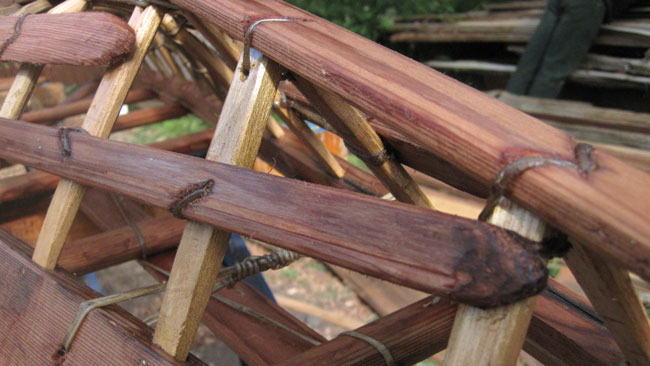
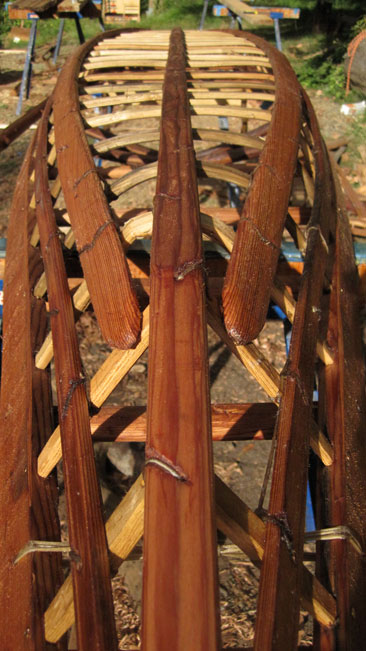
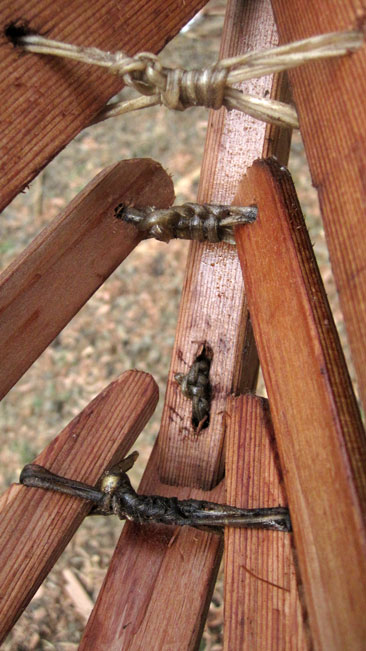
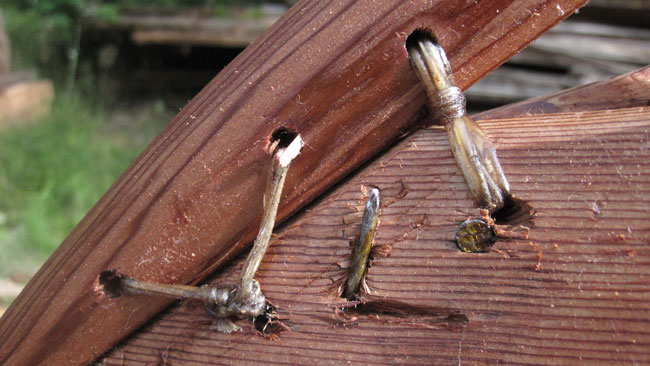
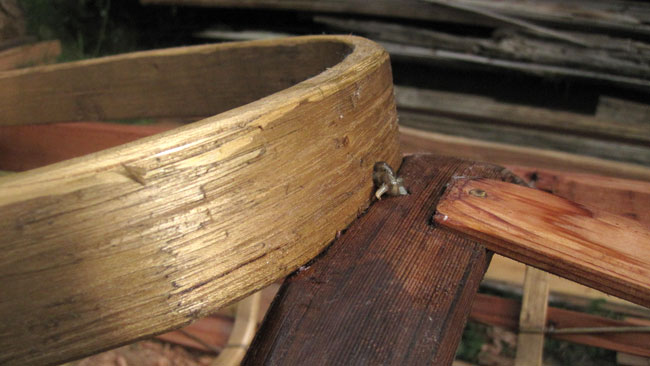
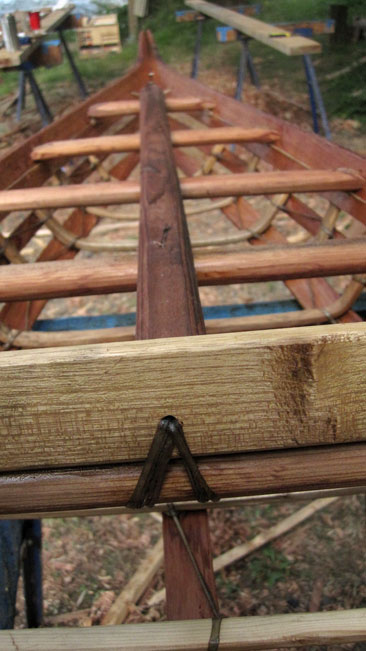
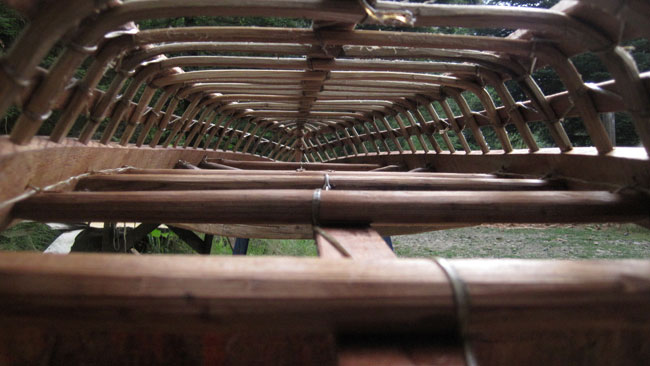
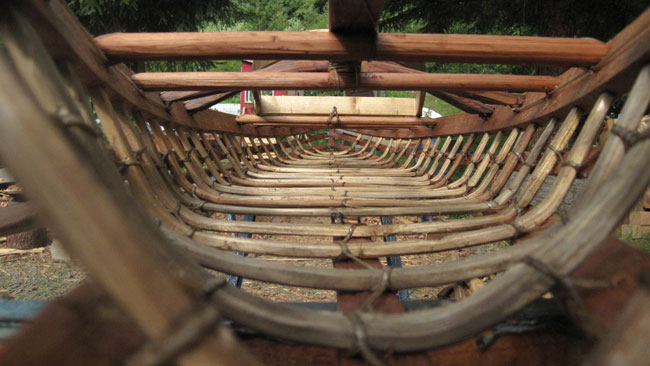
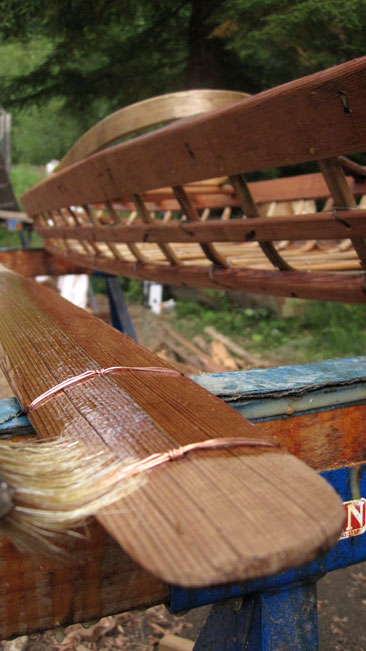
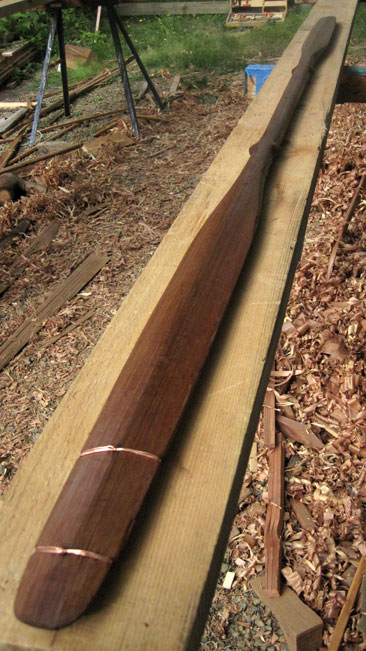
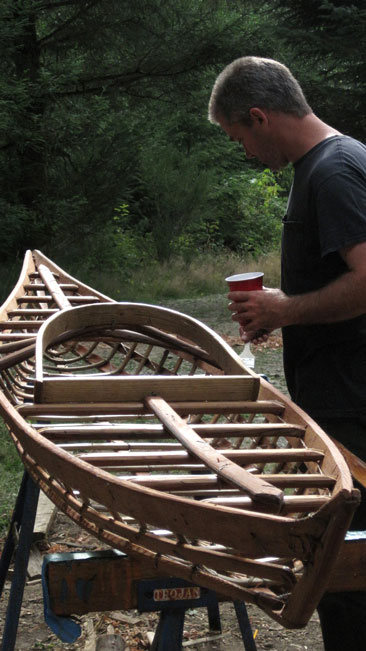
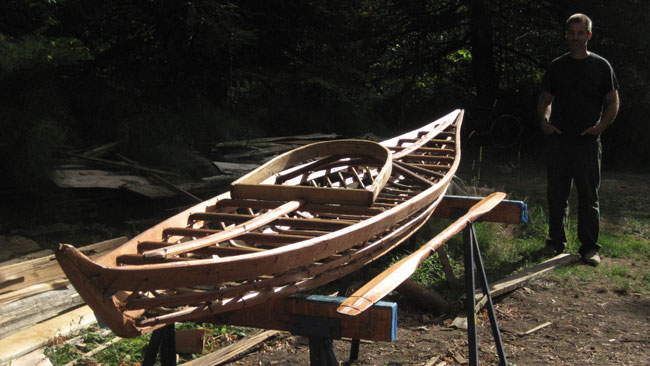
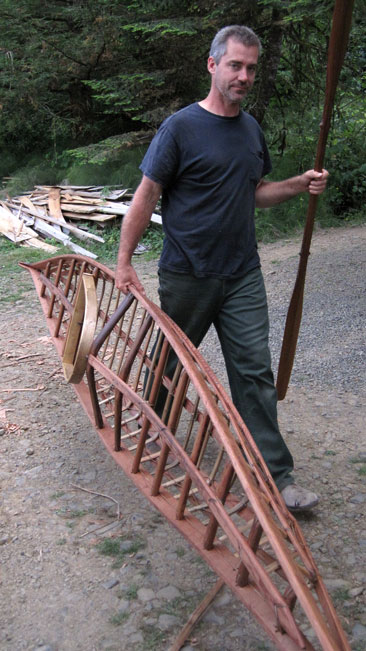
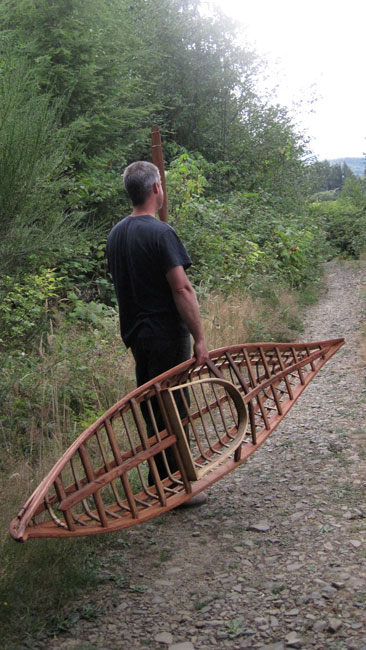
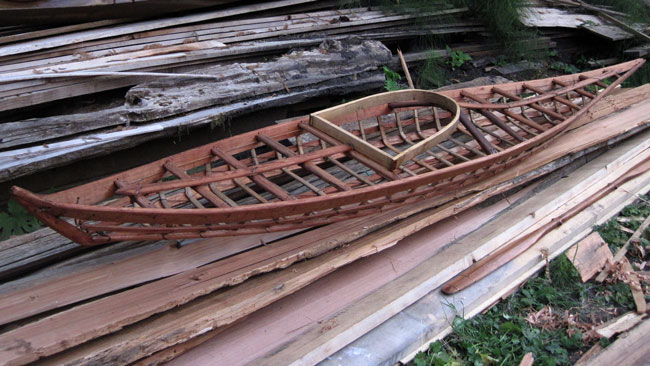
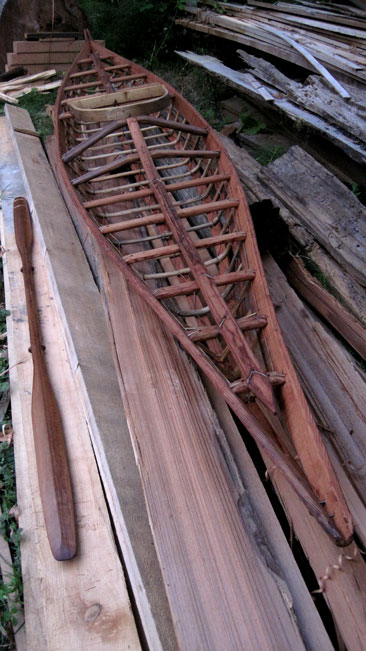
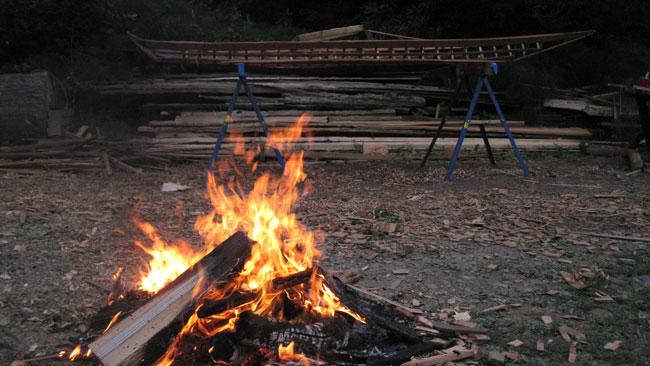
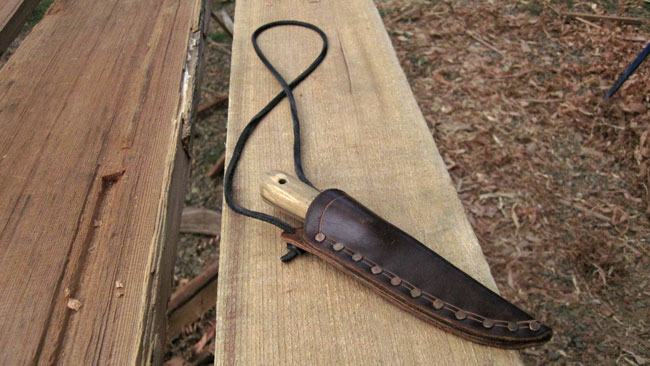
I'm too tired right now to write anything resembling a meaningful conclusion, so for now I'll just take a moment to thank Tom, Patrick, Harvey, Mark, Kathleen, George, and all the other people who made this project possible. Check back in a few days for a written conclusion and a maybe some photos of the survey drawings we worked from. If possible I'll try to find a historic frame photo as well.
Back to Cape Falcon Kayak

Me: "Belcher where?"
Harvey: "They're on the east side of Hudson Bay."
Me: "Your talking to a guy who didn't know where Kansas was until last week."
This spring I received a very unique commission. A gentleman contacted me with a photo of a soapstone print depicting an Eskimo and his kayak. The print had been given to him by his father and he wanted to know what sort of kayak might be represented and whether or not I would be interested in reproducing an nearly exact copy of the original framework (at 3/4 scale) for display. The terms of the commission were that I would research the kayak and produce the frame using no power tools; terms to which I added that I would attempt to recreate the kayak with the tools available to the original builders.
Personally, I hadn't the faintest clue where the kayak might be from, but I did know someone who would. I'm fortunate to have the worlds' eminant kayak researcher for a best friend and a trip to Harvey Goldens house did not dissapoint. In his museum-like living room Harvey pulled books from high shelves, unrolled surveys, and in short order assembled me a binder of relevant information including detailed studies by Eugene Arima, Milton Freeman, and David Zimmerly. The historic photos, surveys, and drawings in these studies provided a strong foundation to begin the process.

Milton Freemans study contained an actual tool list that I used as a guideline for my own tool kit. Originally, little more than an adze, bow drill, and curved knife were used to craft the kayaks. With more European contact came the steel hammer, hewing axe, and brace and bit. More importantly (in my opinion) than exactly what tools were used was how they were obtained. The inuit in general were very financially limited and available tools must have been built, borrowed, converted from other uses, or cooperatively owned. One might imagine the occasional new tool being purchased. I tried to keep this spirit in my own tool kit, the following is a list of my tools and their sources.
- Firewood axe and hatchet: found lying around the farm.
- Steel wedges: also for firewood splitting.
- Brace and bit: bought from a local salvage yard for two dollars.
- Old hammer: found in a corner in my barn.
- Rusty japanese saw: purchased new a long time ago, not very sharp.
- Draw Knife: Given to me by my friend Alec after a winter spent building boats together.
- Hand Adze: Built by my friend Patrick, traded for an old drysuit.
- Scraper: I wish I could remember who made this for me, it's an excellent tool and showed up in the mail one day.
- Small carving knife: Also built by Patrick out of my old band saw blades, traded for an old kayak.

Two years ago my friend Mark and I were out in our kayaks salvaging logs on the river after a flood created several sizable logjams. Wielding chainsaws, cables, and comealongs we liberated a reasonable raft of timber, at no small risk to ourselves! as we were ready to leave for the day, I spotted this rotten looking chunk floating in the mass of debris and pushed it over to the raft. My instincts were right, inside the rough exterior of the broken chunk was a good quantity of very straight, clear grained red cedar. I split the log once to check the interior and then set it aside for a day when I might use it to make a kayak with only hand tools.
Building the kayak: Day 1


I took a deep breath and started splitting with a hammer, axes, and wedges. I tried several techniques to get the best split planks. On thinner stock one can control a split by hammering in wedges along a line that mostly follows the grain and then split the plank, but that techniques only created shards with such tall boards. Ultimately I found the bisecting pieces again and again yielded the best planks.

Of course even the best planks varied in thickness by up to an inch at either end. After splitting out the entire log, I ended up with three usable gunwale boards, and about four boards from which to fashion chines and stringers. Aside from that was a pile of bad boards from which I still might use pieces here and there.
At the end of the first day I looked upon my pile of split planks with a mixture of elation and anxiety as I contemplated what would be needed to hew them accurately into the thickness and complex curves neccesary to form the gunwales. I returned to Harvey's binder and noticed all of the studies and most of the photos showed two or more men working to complete a kayak. I also noticed the prominence of a proper hewing adze. That evening I emailed my friend Tom...
Day 2

I'd like to say that Tom came to work in exchage for half of a freshly killed elk or something of that sort, but truth be told I hired him outright. There is more to the story though. Last year I met Tom when I traded him a kayak building class for help in completing the house that I built with the logs I pulled from the river with Mark. I realized pretty quickly that Tom is an excellent carpenter and ended up hiring him for a few more weeks. I hired him with money I borrowed though, and the profits from the commission we'll be building together will go partially to finally pay that debt. This is one of those rare moments where currency is truly a friendly intermediary in trade. Cash is undoubtedly the most convenient way to transfer value, but with that convenience it also erases the rich relationships that direct trade fosters. With that in mind I felt a little bit sheepish shelling over a substantial amount of cash for this brand new broad axe and hewing adze. My firewood hatchet simply wasn't going to get the job done.

The first thing I did was hand Tom the binder. "Here you go," I said, "first you're getting paid to read." Afterwards reading the binder cover to cover, Tom set to work with a mill file and diamond file, sharpening the edges of all of our tools. I've made the mistake of handing that job to the wrong people before only to have them ruin all my blades, Tom is more than capable though.

One of the most difficult tasks was creating an accurate gunwale template. The above illustration shows roughly how the gunwales should be shaped to create the correct sheer line. We needed something more definate though, before we took and adze to our precious split planks. I read and reread the parts on shaping, looked at all the surveys, and stared at the grainy photos until my eyes went blurry.

After about 3 hours of trial and error Tom and I created this half-scale model of the full size gunwales to use as a shaping guide for the full size gunwales. The template shape ultimately ended up agreeing very closely with the illustration above. From the exercise we gained both a vertical height for the plank we needed, and the confidence to move forward on the actual planks.
Day 3

After a short review of the drawings and our model frame, our first task was to cut the gunwales to length, 12 feet 7 inches to make 3/4 scale. At 14 -18 feet the Belcher kayaks were quite short for their region. Even this decision took some time as we carefully examined the boards and chose the cuts to allow cracks, rot, and other defects to fall outside the finished gunwale lines.

The planks were still quite thick so I carefully drove a froe into the ends to thin them down.

I then used the small drawknife to clean up the surfaces and make the plank reasonably flat and straight, alternately cutting and flipping the plank on edge to sight the line.

With a clean surface I layed out the gunwales according to the measurements we determined yesterday.

Originally this shape would have been adzed but neither of us are good enough with the adze yet to take such bold bites, so we chose to cut down to the lines.

We used the broad axe to chop out the kerfs.

The stern 'knob' on this kayak is quite pronouced.

Tom tried planing the rough edge...


...but we both decided the draw knife worked better.

The finished shape is laid onto the second plank and traced for a matching gunwale.

The gunwales are still nearly twice as thick as they should be. Tom removes thickness with the adze but again we are both nervous with the agressive hewing adze, it would be easy to ruin the gunwales with a single stroke.

We discovered that by referencing a flat surface we could accurately scribe that surface onto the gunwale. Then we cut kerfs down to the line every eight inches and chopped out the wood with the broad axe.


We finished the surfaces to their final thickness (aprox. 3/4 inch) with the draw knife.

Not all defects can be avoided. This deep void in the bottom of one gunwale only became apparant near the end of the shaping. It shouldn't be a problem.

With the gunwales complete we tied the ends together and forced in spreaders that were little more that quickly split sticks. With one guy holding and the other pulling a saw through the tips we were able to fix a reasonably appropriate flare. I accidentally cut myself and the rope during this procedure. The stern was VERY difficult to force closed as the bend it takes forces the gunwales close to breaking.

Our progress for the day. Both Tom and I noticed that our finished sheer was slightly humped up in the middle. This absolutely perplexed both of us because they are exact copies of the smaller model we made, with a flat sheer in the middle. We increased the flare slightly which helped and still kept the flare within historic parameters. Nevertheless, in the morning we will need to reshape the gunwales a bit to get an accurate sheer line.
Day 4

I spent the early morning reshaping the gunwales. I took this opportunity to also thin the ends somewhat to make the bending easier in the stern. In the original it would have be done by sawing deep oblique cuts from the interior face, but without an elder to show me exactly how to do that it seemed like a great way to break the gunwales.


Tom worked on splitting and shaping the deck beams.


The revised sheer looked much better so we moved our attention to other tasks. I proposed we take a field trip to the beach to begin searching for a natural crook for the masik, as well as stock for the ribs.

Despite an impressive driftwood supply on our local beaches, and perhaps even because of it Tom and I were having a hard time finding just the right pieces for the masik. Most of the wood was extremely dry from the summer heat and we weren't feeling really confident about finding good stock to split staves to shape into rib stock for bending. After three hours of searching on two different beaches we returned home with this single crook. More than anything, our beach forays just didn't 'feel' right.
I thought perhaps that in our desire to use beach salvaged wood for literal authenticity, we were ignoring the conceptual authenticity of the project. With the day dwindling away I decided to take a look at the situation with fresh eyes. The Inuit builders didn't find their stock in an afternoon, appropriate pieces were cooperatively gathered throughout the year from local areas.

A natural furniture builder, Kathleen is the most tenacious driftwood gatherer I know. She was happy to let Tom and I pick through her crooks to look for masik stock, and the best part is that we only had to walk across the street to the shop I share with her. I will undoubtedly trade her something, likely fish or labor, for the use of her wood. After meeting with Kathleen I felt we were on the right track.


Back at my farm I looked again through my wood and found this small rough piece of black locust. Locust is incredibly strong, rot resistant, and bends very well under ideal conditions. This locust however had been drying and cracking in the sun for years and was very hard to cut and split. Locust is extremely cohesive and even in short lengths it resisted our efforts to split it.
I reflected back to where this locust actually came from, it was three years ago in the same salvage operation that our gunwale log came from that Mark peered into the murky water and said, "I think that's black locust." Naturally I assumed he was full of shit. How can anyone look at a dirty, slimy, barely visible, nondescript limb and know anything? Sure enough, it was locust and we cut it back to where our chainsaws could no longer reach down into the water.
Back in the present I looked over to Tom and mused, "I wonder if the rest of that limb is still down there?".

Fifteen minutes later we were pushing our kayaks down the muddy bank and into the north fork Nehalem river a mile from my house. Here you will notice the conspicuous presence of a non-approved motorized tool. I reasoned that it was insane to try to cut the hard locust underwater by hand, although I'm not sure how I thought I would reach the wood, seeing as we could not reach down to it with chainsaws before.

I'm more proud of the tools on my foredeck.

We headed down the shallow narrow river, chopping at random protruding sticks, usually with little idea what they were even after hacking into them. My memory of where Mark and I found the locust was pretty hazy, and things move a lot in a few years. I floated over a suberged limb-end of about the right diameter and reached over the gunwale with my handsaw to cut out a small wedge underwater. I pulled it up and noticed extremely tight growth in the tiny wedge. I called Tom over, "I think this is it!"

This is my karmic punishment for even thinking about using the chainsaw. The other end of the limb was deep underwater leaving little choice but to reach down with the hand saw. I expected it to be a simple procedure...

...and I was wrong. The limb made a deep arc down into the water and protruding straight down from the center of that arc were two strong side branches that held the log firmly underwater even with both end of it cut through. I had no choice but to dive down and saw furiously at the limbs while holding my breath.

Coming up for air, the water is not warm.

Once liberated the locust sunk like a rock and we were wise to have a rope on it. I dragged it ashore to cut the limb in half. We strapped the heavy half to Toms F1 and the lighter half to my greenland kayak, still, the fifty pound limb nearly submerged my back deck.

Tom strapped the limbs onto the car while I shivered and dripped water in my blue jeans and t-shirt. Tomorrow we'll find out if the locust was worth the effort.
Day 5
(the day I crashed my truck into the grocery store)

I woke up early this morning to get in a surf session in the freshly modified 'bat boat'.

There was a decent swell but it just didn't clean up, leaving me hunting for peaks and dropping in where I could. Still, it was a gorgeous morning and I was pleased with the bow and fin changes on the boat. I drove the 'death mobile' (our farm beater truck) through town still dripping in my wetsuit, stopping to spray off my feet outside a local shop.
Then it happened.
I glanced back in horror just in time to see my truck roll out of it's parking space and backwards down the hill. I forgot that the parking brake doesn't work on the death mobile. I futily gave chase as the truck crossed both lanes and gathered speed as it headed straight for the local grocery store. Barely missing a square collision with the corner of the building it rode up onto the sidewalk and rasped it's way across the storefront siding, annihilating two sitting benches, three planters, a garbage can, and an entire display of watermelons before lodging firmly in the front doorway. Amidst the formidable carnage of splintered wood, potting soil, and red watermelon chunks I looked directly across the bed of my pickup at the Asian store owner now blocked inside. What does one say at times like these?
"I'm really sorry I crashed into your store Chung."
What else can you say? To make the story short, I agreed to fix any damage and Chung agreed not to have me arrested, and about a hundred rubbernecking tourists took the personal liberty to tell me how lucky I was in a condescending tone that seemed to imply that they dissaproved of red-bearded bald men in wetsuits driving beater cars in their holiday town, my town.

Glad to be back at the farm I started the workday with a green alder branch to determine an appropriate length for the longest rib.

We cut both the wet and the dry locust into shorter lengths and Tom split those lengths again and again to make staves from which to carve ribs.


The locust resisted our work the entire way, but Tom was persistant and spent the entire day roughing out ribs....

...and planing them down to oval shapes.

I occupied my day by slowly turning this crook into a masik.


Hewing the masik was surprisingly tough work as I learned control with the broad axe and hand adze. The crook had a lot of cracking and wild grain and one bad blow with the axe would be enough to ruin it. I learned to use the small adze with a quick pecking motion which worked quite well. Finally I planed the masik smooth and scraped the convex surface as smooth as I could.

Standing knee deep in chips one starts to feel like a beaver.

The finished masik, it only took me six hours!

I gouged out a small blind mortise for the masik with my pocket knife and shaped the end accordingly.


Drilling holes for the masik lashing.


The masik is lashed in place with deer hide lacing crafted by my friend Patrick. The lacing is amazingly even considering that it is spiral cut in long lengths from a single hide. The masik joint, the holes, and the lashing pattern are all taken directly from an excellent drawing in Eugene Arimas study: Notes on the Kayak and it's Equipment at Ivuyivik, 1961.

Meanwhile Tom has been boiling test ribs from both the dry and the wet locust in this 20 gallon pot set over an open fire in the driveway and fed with wood from our work.

The dry locust bent surprisingly well and looked a lot like what we saw in photos of the original kayaks, broken, but not entirely.

The wet locust bent almost too well and I had to really force it to get it to crack. This sharp turn in the bilge is intentionally very abrupt. One masik and twelve ribs, (we test bent 5), not much work for two guys working an entire day.
Day 6

I began the day doing some shaping on the gunwales, while Tom worked on making ribs for the kayak. The locust proved incredibly tough to work and eight straight hours of hewing ribs definately took it's on his hands. Above you can see the incredibly tight grain of the limbs Tom was working on.

I also pretty much did the same thing I did the day before.

Roughing out curved deck beam number two.

Planing the curved deck beam. This one only took me 3 hours to build, twice as fast as yesterday!

After rough hewing the third deck beam it split and I had to discard it and search out a replacement crook. I found this wildly curving dry branch that contained any number of radiuses on it's 3 dimensional curves.

Matching the curve from the split piece.

I cut the blind mortises by hand with a sharp knife, it was both easier and faster than using a drill. After the masik position was scaled from the drawing and marked, I marked the rest of the deck beams using only my hand to measure and cut all the mortises by eye.

Both Tom and I are professional woodworkers and by the end of this day our hands hurt! Still two deck beams shy of what I had hoped, everything on this project takes longer than I expected. I hoped to have the deck finished today but it will likely take until the end of tomorrow.
Day 7

I woke up early this morning and started by pulling out the deck beam I'd replaced yesterday and replacing it again because the curve wasn't right. I carved this last beam out of a solid block of split cedar.

As per the original, I nailed the ends of the gunwales together once I finished placing all the deck beams.

Satisfied with the finished deck beams I started drilling holes for lashing. This small stanley eggbeater drill was frustrating to use.

Noticing my frustration Tom loaned me his grandfathers old eggbeater and the difference was like night and day, it drilled quickly and smoothly.


Meanwhile Tom split out wood for the stringers.

Suddenly Tom yells, "Hey, you gotta see this!" Tom had split right into a hidden pocket of black ants!

Tom planes the stringers.

I untangled a one hundred foot continuous piece of wet deer hide lacing to get ready for the deck lashings.

I used a scrap of tie wire as a needle to thread the continous deck lashings.

The beginning of the lashing.

Continous deck beam lashings pull the deck beams into the blind mortises.

With the deck tied I started marking for the rib mortises. I chose a hand measurement of roughly 3/4 the original hand measurment.

Mortises were drilled with a bit and brace and roughly chopped out with a chisel.

Deck beams and mortises at the end of the day. Good progress.
Day 8

First thing in the morning Tom lit the fire, it takes a long time to heat up 20 gallons of water.

Although the original guys would have bent the ribs in by eye while steaming, I chose to mock up a few of the ribs with twigs first to get an idea of what lengths we would need. I discovered that a simple hand measurement would suffice to get approximate lengths for the finished ribs.

The ribs are a mixture of wet and dry locust, hewn down to size.

I precut the rib stock to approximate lengths and installed a few of our test ribs from yesterday.

We boiled the ribs in the pot for a few hours before Tom pulled them out one by one.

This may look hideous, but it is exactly what we were supposed to do. This is probably the most extreme case, but still an entirely usable ribs with most of the bent wood still intact. Most of the ribs on the originals were broken worse than this one is.

This is probably ideal, providing a hard turn at the bilge with not too much splitting.

Bending in the ribs.

After bending in the ribs I made extensive use of the saw to trim the ribs down to get a fair shape.

Rather than go and try to find some rusted nails to make things look 'authentic' I grabbed some bronze nails from the shop and Tom nailed in the ribs as per the original we are copying.

The stringers on these boats were almost always hollowed out to wrap over the curve of the ribs and hide the broken sections. We pondered for a while on how to cut this hollow and finally decided to try to make a curved knife. I grabbed a knife from my kitchen and heated it with a propane torch, using the back of the froe to pound it to shape.

We quenched it in the rib boiling pot and decided it didn't feel too brittle so Tom put an edge on it and we gave it a go.

Success! not ideal but it does the job.

Our final task for the day was to bend the coaming from a two-inch by half-inch dry locust piece that Tom hewed earlier in the day. We draped a towel over the ends to get the steam across the entire lengh.

Bending the curved part of the two-piece coaming was very difficult and we re-boiled it six or seven times to try and get the shape right.

Eventually we broke down and pulled out some clamps to force a better shape.
Day 9

Yesterday evening Tom and I looked at the lines of the completed deck and decided that, although within historic variation, the masik and curved deck beams were too obtrusive looking. So first thing this morning we cut the lashings and removed ALL the curved deck beams to replace them with new ones of a lower (but still within historic variation) profile. Here you see the cut lashings soaking in water so they can be reused to lash the new beams in place.

Having already cut our teeth on natural crooks we chose to cut our replacements out of solid cedar blocks. With the grain oriented vertically this is more than strong enough and I would, (and have) use it in my own kayaks.

It was difficult to replace two days of hard work with new curves only slightly lower than the old ones, but not to do it and know I should have would have been worse. That said, I was still pretty cranky about losing a whole day.

With the curved deck beams rebuilt and tied in we turned our attention to the deck stringers. A shallow mortise is cut in the deck beam to recieve the stringer.

The stringer is fastened with a single nail. It could have been lashed, screwed, or left untouched.

Holes are drilled and deep notches are cut for the continous deck lashings.


The terminus of the bow and stern deck stringers.

Next we worked more on the coaming. In Eugene Arimas study he mentions that in the rebuild of a kayak he documented, the native builder used a 'small oblong plate of copper, and one of antler' to back the screws used to fasten the straight piece of the D shaped coaming to the curved piece. The plates prevented splitting of the wood so close to the end grain. I fell in love with this small detail and although I could have copied any number of coamings constructed more simply, I chose to reproduce it for this kayak.
I fashioned a plate of copper by hammering an old piece of copper pipe flat and cutting the outline with tin snips, finishing it on a mill file. Here I must confess to using a power drill and a Fuller countersink to carefully pilot the hole. I simply don't have the experience to pilot this by hand and achieve predictible results, and the idea of a bronze screw broken off deep inside a piece of wood we spent two days building and had no stock to replace, was simply an unacceptable risk. The screws were waxed and driven by hand.

Our deer antlers are not hard like caribou antler, so I chose instead to make a thin ivory plate for the opposing side. This was cut from a small piece of a walrus tusk that a friend gave me six years ago. Again, having absolutely no clue how to cut and carve ivory by hand, I carefully used a band saw and edge sander to make this tiny plate.

The completed coaming.

Our progress at the end of the day.
Day 10

We started the morning by splitting out a blank for the paddle from an absolutely gorgeous piece of clear cedar.

Harvey came through with a paddle survey for Tom and I to work from.

Tom in a common pose, hacking away with the broad axe.

Tom spent the day carving the paddle.

I pieced in the last ribs in the bow and started the keel lashing.

The lashing alternates and is let into grooves in the keel.

A close up of the lashing.

The keel is notched in at the bow and lashed down with a simple lashing.

While the keel is normally bent up into the gunwales on most East Canadian kayaks, on the Belcher kayak we are copying a distinct stern post is visible and is referenced in the text. I attached it to the keel with a simple round lashing and to the gunwales with a V lashing. The V lashing is likely not correct but we had no details on how this was supposed to be tied.

A small repair was neccessary when the fragile stern 'swoop' cracked.

When it came time to lay on the stringers and lash them down it became horribly apparant that no amount of torturing would cause them to conform to the correct shape. After carefully scrutinizing the historic photos it was clear that these pieces must have been cut from curved stock and shaped into a curve as well. This is another place I could have 'cheaped out' and just lashed them down and not mentioned the discrepancy. After so much work already I could hardly do that though.

So we began the slow, painful process of hewing new CURVED stringers from rough split TWO BY EIGHTS.

Not what I was hoping to be doing right now.

After flattening two surfaces the planks were nailed face to face with a curve drawn on them and I spent a somewhat violent twenty minutes chopping out the rough curve with the big adze.

The rough curve.

Further thinning with a draw knife.

This entire mess is from shaping the stringers.

The nearly finished stringers at 8pm.

Tom cuts new hollows with our makeshift curved knife after a twelve hour day.
Day 11

Every morning my very shy bengal kitten Spot takes a much hated trip to the main house to play with the other cats. In the usual routine I reached down to grab her by the scruff and oddly she slipped out of my hand. Incredulous, I tried again harder and again she slipped free. Ten days of hard lashing and hewing had reduced my aching digits to one of those loose robot claws that drops into stuffed animals at arcades. I settled for pinning her down with a towel and bundling her up. I needed to finish the boat today.
Tom and I worked non-stop all day long to finish the kayak, finishing it up by slathering the whole thing with raw tung oil mixed with turpentine. Oil isn't traditional but it sure makes the frame look beautiful. Finally we swept the shavings into a formidible pile and lit it on fire. The following photos describe our progress as well as my text would, and honestly, I'm too tired to write copy, which is a pretty rare thing for me.


















I'm too tired right now to write anything resembling a meaningful conclusion, so for now I'll just take a moment to thank Tom, Patrick, Harvey, Mark, Kathleen, George, and all the other people who made this project possible. Check back in a few days for a written conclusion and a maybe some photos of the survey drawings we worked from. If possible I'll try to find a historic frame photo as well.
Back to Cape Falcon Kayak